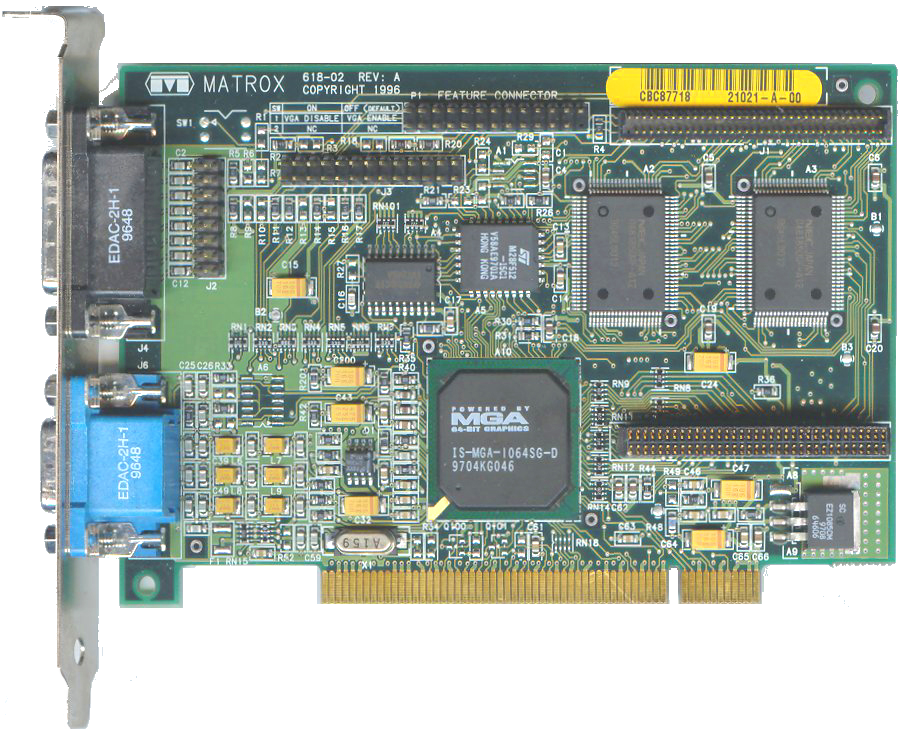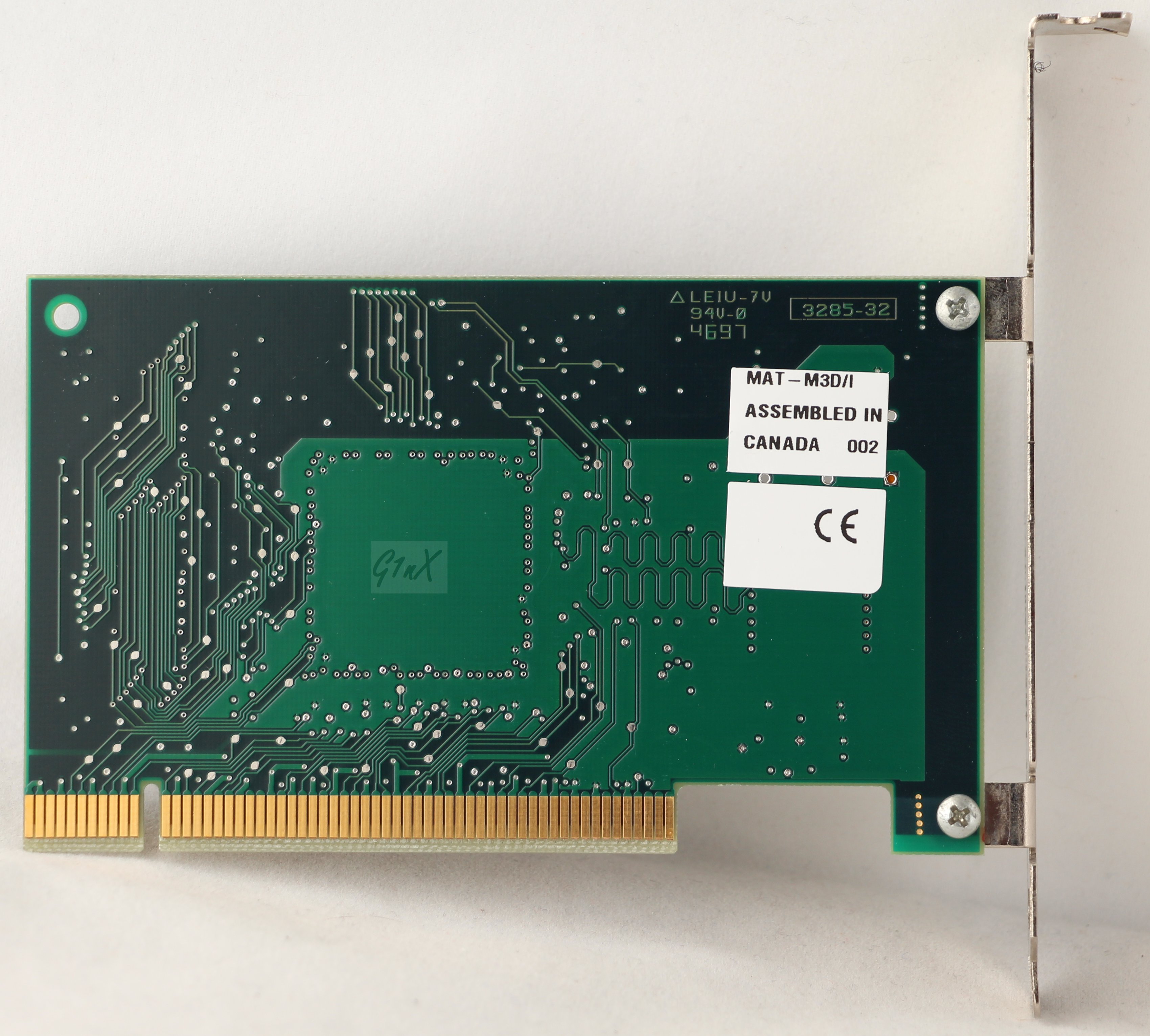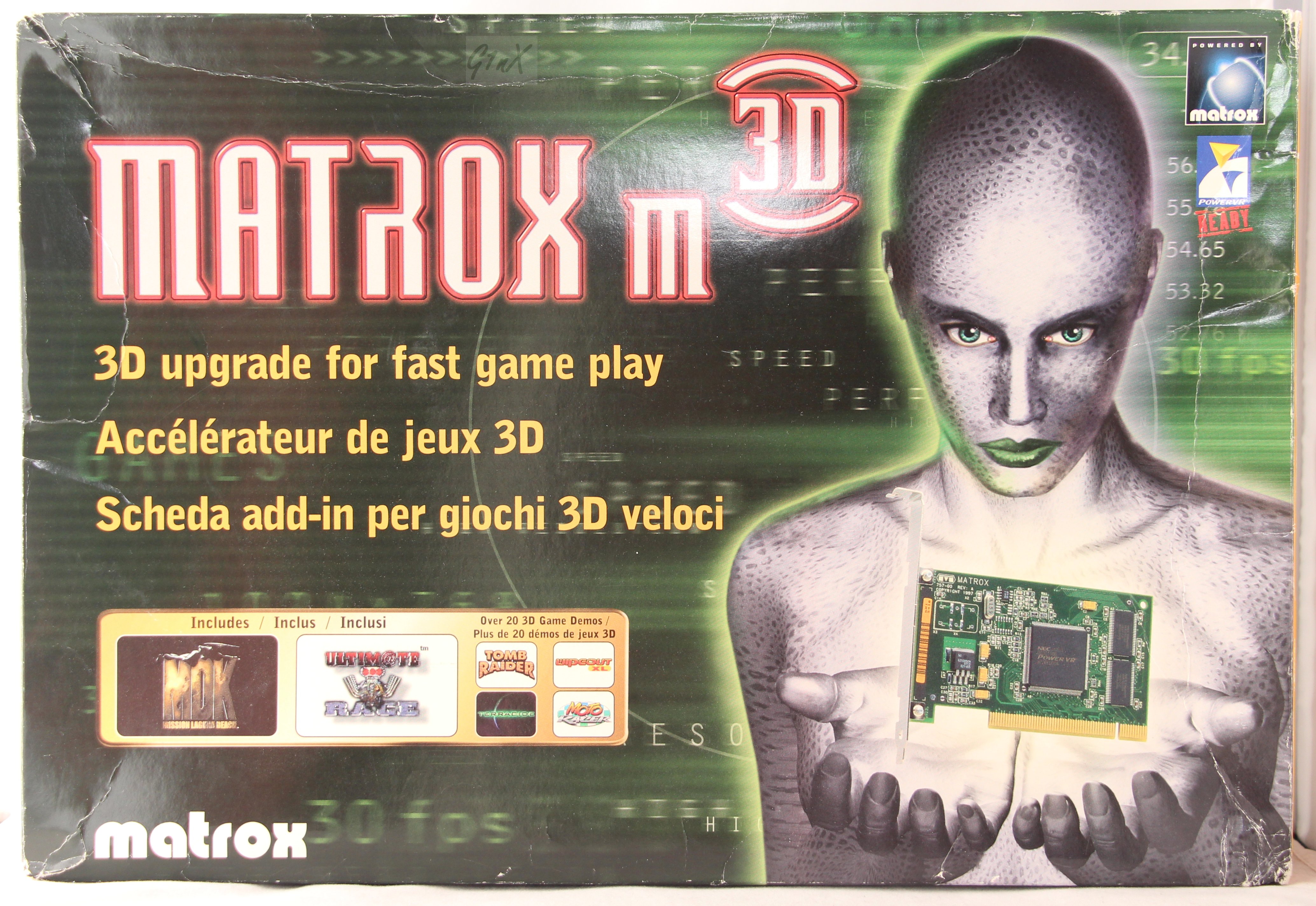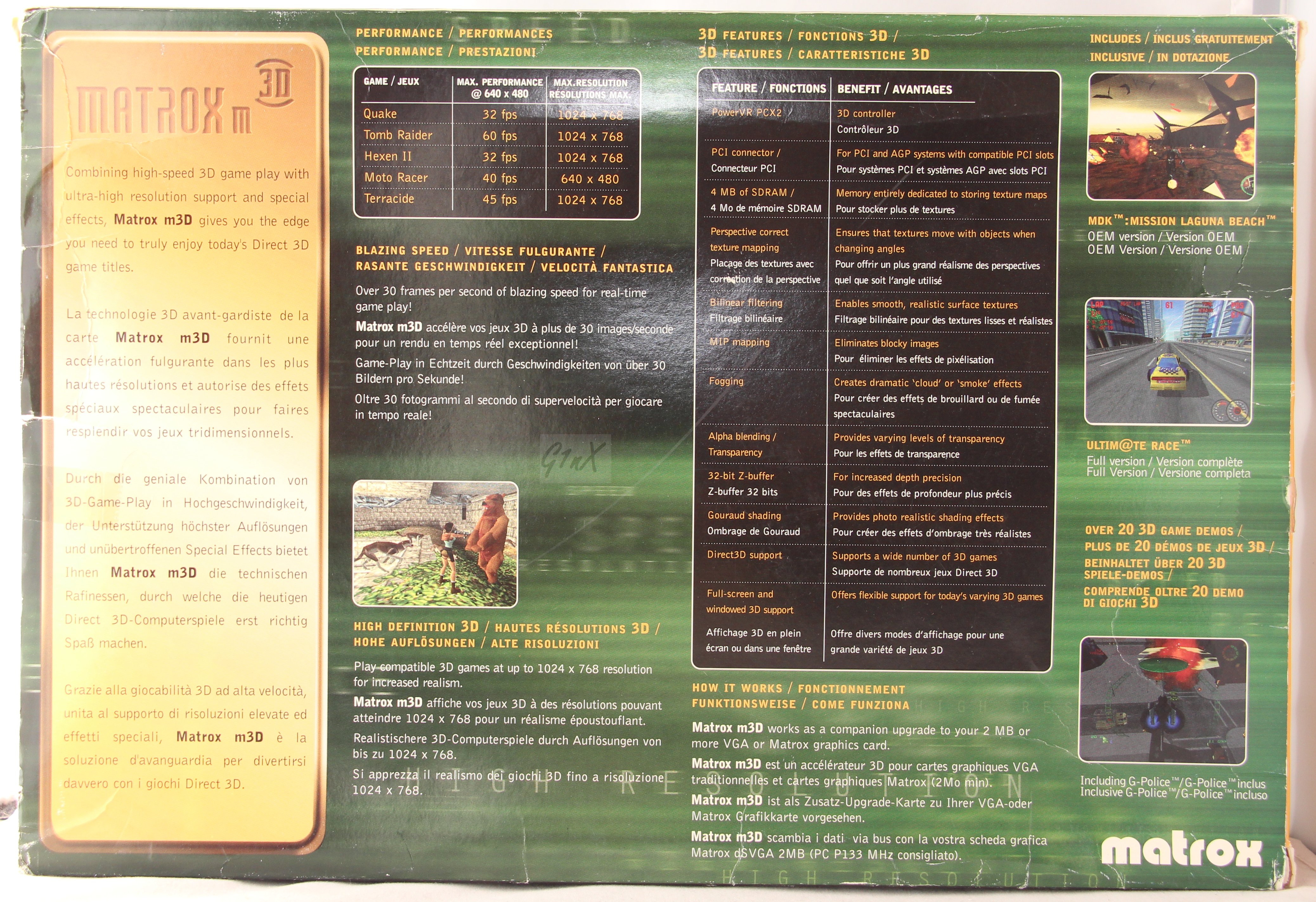Matrox Graphics, Inc.
Matrox was a Canadian graphics card manufacturer for the IBM PC and its compatibles, based in Montreal and was founded way back in 1976. Though they started out producing "frame grabbers" for various hardware, the company really took off from 1994 to 1995 with revenues jumping from $120M to $250M. From 1993 they had stopped used third-party chipsets, instead choosing to design their own - the first of these was to be used on the Impression and Impression Pro video cards.
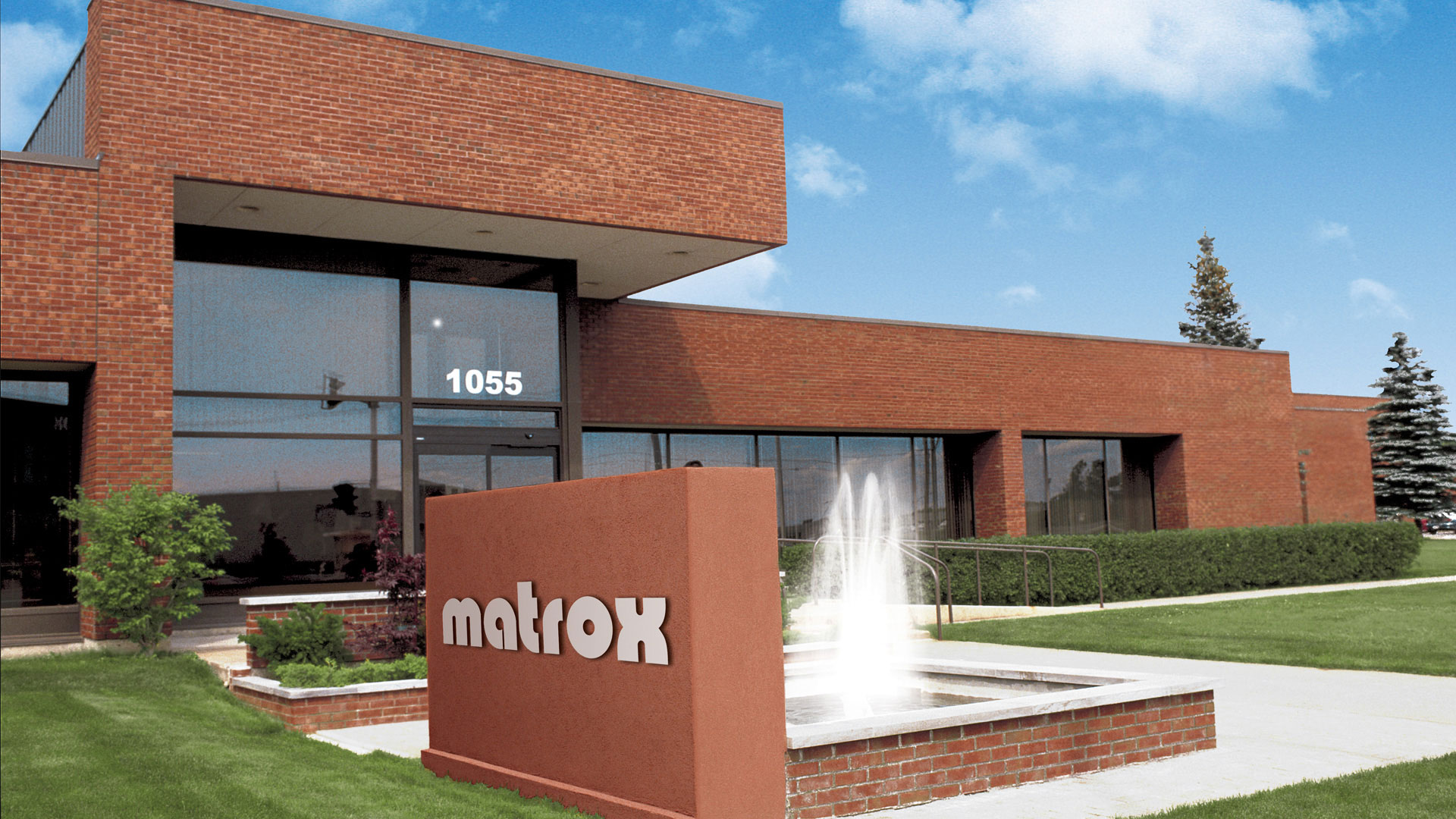
They were probably most famous for their MGA (Matrox Graphics Architecture) engine, launched in May 1993, which was a 64-bit engine that produced superior 2D graphics (important during the era of CRTs) and also had a reputation for being high performers. Similar to ATI's Mach32 and S3's 86Cxxx family of chipsets, MGA accelerated common graphics functions such as BitBlts (bit block transfers) and pattern, polygon, and rectangle fills. It went one better though, and also provided acceleration for 3D Gouraud shading, z-buffering, and character drawing. It was optimised for 486- and Pentium-class computers and was designed with PCI in mind, with its 128-bit bus: 64-bit for graphics (twice as wide as most existing graphics accelerators at the time) and 64-bit for video output. There was also an NTSC/PAL encoder daughterboard called VideoPro that could be installed on MGA cards to provide broadcast-quality TV video output to your desktop.
They were also notably remembered for their multi-display capabilities, with "dual-head" and even "quad-head" graphics cards to drive up to 4 displays at once.
Matrox even provided games developers with their API, called MSI (Matrox Simple Interface), though this was not widely adopted and eventually only 12 titles directly supported MSI. MSI was limited to games that supported 640 x 480 x 16 with Z-buffer sorting and no bilinear filtering.
With the introduction of 3D accelerators in the mid-to-late 90s, Matrox gradually became unable to keep pace with the competition from nVidia and ATI. In 2002, they launched their final 3D graphics card, Parhelia-512, before pulling out of the consumer graphics card market to focus on more niche industries, such as CAD and the multi-display features they were so strong in.
Matrox resides at 1025 St. Regis Blvd. Dorval, QC, Canada, H9P 2T4 Tel: (514) 969-6320 Fax: (514) 969-6363
The company still exists today, and in September 2019 one of the original founders took back 100% control of Matrox.
Here's a summary of the Matrox cards in chronological order, and by bus type:
| ISA / VLB Cards | PCI Cards | AGP Cards |
|---|---|---|
| ISA Cards: Hiper+/WIN (1992) MGA Impression (1993) MGA Impression Pro (1993) MGA Impression Plus / Impression 200 (1994) VESA Local Bus Cards: MGA Ultima (VLB, 1993) MGA Ultima Plus / Ultima 200 (VLB, 1993) |
MGA Impression Plus / 200 (1994) MGA Millennium (1995) Mystique (1996) Millennium 2 / Millennium II (1997) Millennium m3D PCX2 (1997) Mystique 220 (1997) Millennium G200 Quad (1998) Millennium G450 (2000) Millennium G550 (2001) |
Millennium 2 / Millennium II (AGP 1x, 1997) Millennium G200 (AGP 1x, 1998) Mystique G200 (AGP 1x, 1998) Millennium G250 (AGP 1x, 1998) Millennium G400 (AGP 1x/2x/4x, 1999) Millennium G400 Max (AGP 1x/2x/4x, 1999) Millennium G450 (AGP 1x/2x/4x, 2000) Millennium G550 (AGP 4x/8x, 2001) Millennium P650 Dual Head (AGP 4x/8x, 2002) Millennium P650 Low Profile (AGP 4x/8x, 2002) Parhelia / Parhelia 512 (AGP 4x/8x, 2003) |
|
||||||||||||||||||||||||||||||||||||||||||||||||||||||||||||||||||||||||||||||||||||||||||||||||||||||||||||||||||||||||||||||||||||||||||||||||||||||||||||||||||||||||||||||||||||||||||||||||||||||||||||||||||||||||||||||||||||||||||||||||||||||||||||||||||||||||||||||||||||||||||||||||||||||||||||||||||||||||||||||||||||||||||||||||||||||||||||||||||
|
||||||||||||||||||||||||||||||||||||||||||||||||||||||||||||||||||||||||||||||||||||||||||||||||||||||||||||||||||||||||||||||||||||||||||||||||||||||||||||||||||||||||||||||||||||||||||||||||||||||||||||||||||||||||||||||||||||||||||||||||||||||||||||||||||||||||||||||||||||||||||||||||||||||||||||||||||||||||||||||||||||||||||||||||||||||||||||||||||
|
||||||||||||||||||||||||||||||||||||||||||||||||||||||||||||||||||||||||||||||||||||||||||||||||||||||||||||||||||||||||||||||||||||||||||||||||||||||||||||||||||||||||||||||||||||||||||||||||||||||||||||||||||||||||||||||||||||||||||||||||||||||||||||||||||||||||||||||||||||||||||||||||||||||||||||||||||||||||||||||||||||||||||||||||||||||||||||||||||
|
||||||||||||||||||||||||||||||||||||||||||||||||||||||||||||||||||||||||||||||||||||||||||||||||||||||||||||||||||||||||||||||||||||||||||||||||||||||||||||||||||||||||||||||||||||||||||||||||||||||||||||||||||||||||||||||||||||||||||||||||||||||||||||||||||||||||||||||||||||||||||||||||||||||||||||||||||||||||||||||||||||||||||||||||||||||||||||||||||
|
||||||||||||||||||||||||||||||||||||||||||||||||||||||||||||||||||||||||||||||||||||||||||||||||||||||||||||||||||||||||||||||||||||||||||||||||||||||||||||||||||||||||||||||||||||||||||||||||||||||||||||||||||||||||||||||||||||||||||||||||||||||||||||||||||||||||||||||||||||||||||||||||||||||||||||||||||||||||||||||||||||||||||||||||||||||||||||||||||
|
||||||||||||||||||||||||||||||||||||||||||||||||||||||||||||||||||||||||||||||||||||||||||||||||||||||||||||||||||||||||||||||||||||||||||||||||||||||||||||||||||||||||||||||||||||||||||||||||||||||||||||||||||||||||||||||||||||||||||||||||||||||||||||||||||||||||||||||||||||||||||||||||||||||||||||||||||||||||||||||||||||||||||||||||||||||||||||||||||
|
||||||||||||||||||||||||||||||||||||||||||||||||||||||||||||||||||||||||||||||||||||||||||||||||||||||||||||||||||||||||||||||||||||||||||||||||||||||||||||||||||||||||||||||||||||||||||||||||||||||||||||||||||||||||||||||||||||||||||||||||||||||||||||||||||||||||||||||||||||||||||||||||||||||||||||||||||||||||||||||||||||||||||||||||||||||||||||||||||
|
||||||||||||||||||||||||||||||||||||||||||||||||||||||||||||||||||||||||||||||||||||||||||||||||||||||||||||||||||||||||||||||||||||||||||||||||||||||||||||||||||||||||||||||||||||||||||||||||||||||||||||||||||||||||||||||||||||||||||||||||||||||||||||||||||||||||||||||||||||||||||||||||||||||||||||||||||||||||||||||||||||||||||||||||||||||||||||||||||
| Resolution | Max. Refresh Rate (Hz) | Max. Colour Depth |
|---|---|---|
| 1600 x 1200 | 60* | 8-bit |
| 1280 x 1024 | 85 | 8-bit |
| 1152 x 864 | 75 | 16-bit |
| 1024 x 768 | 85 | 16-bit |
| 800 x 600 | 85 | 32-bit |
| 640 x 480 | 85 | 32-bit |
*Mystique 220 is able to display 1600 x 1200 at 75 Hz refresh rate.
The first Mystiques came with a 50 MHz core and memory running at 75 MHz. Without changing the model or version, a variety of flavours seemed to follow, such as 55/82.5 MHz and 60/90 MHz. It appears Matrox spent 1996 to mid-1997 gradually raising the Mystique's clock speeds.
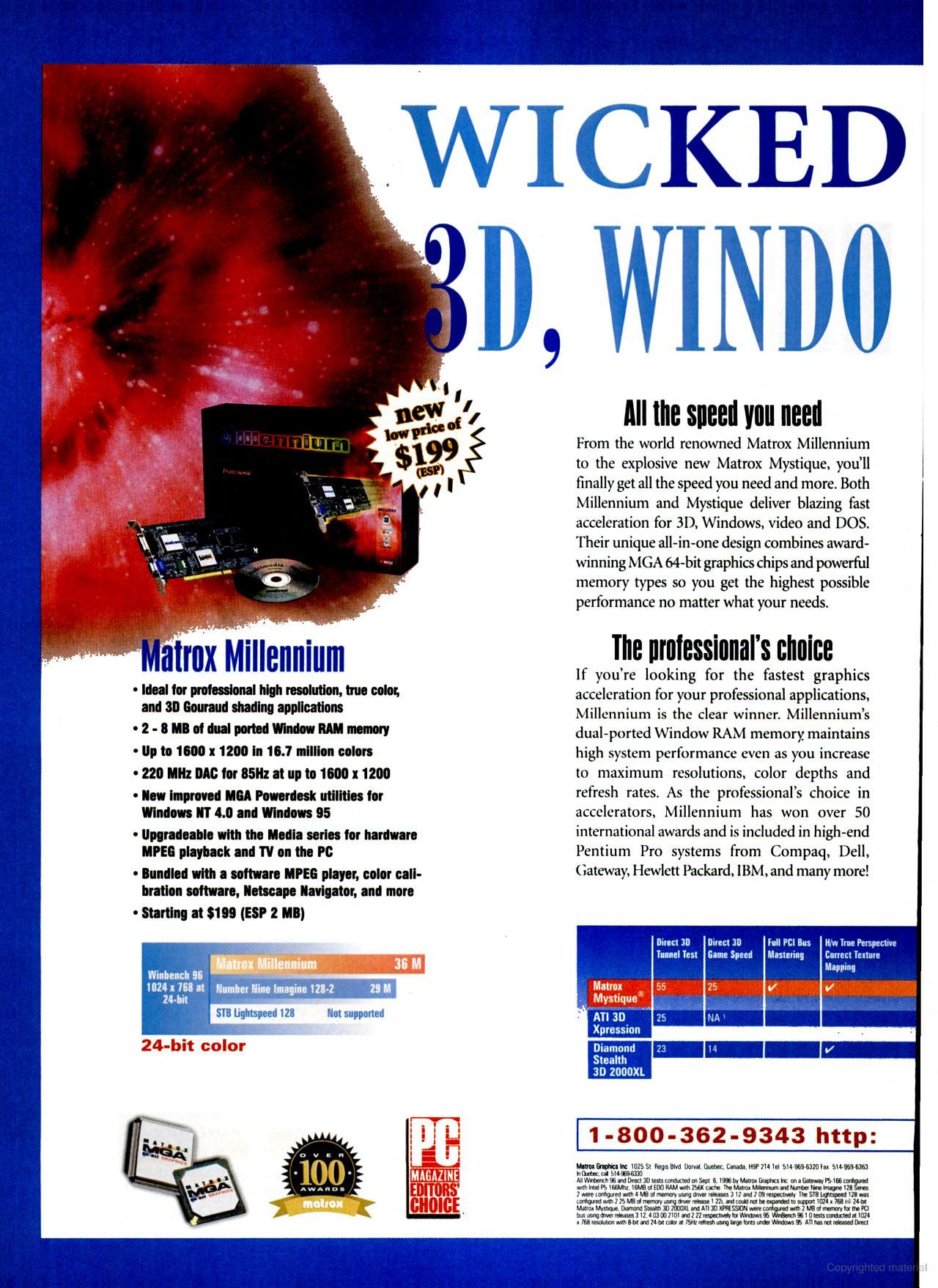
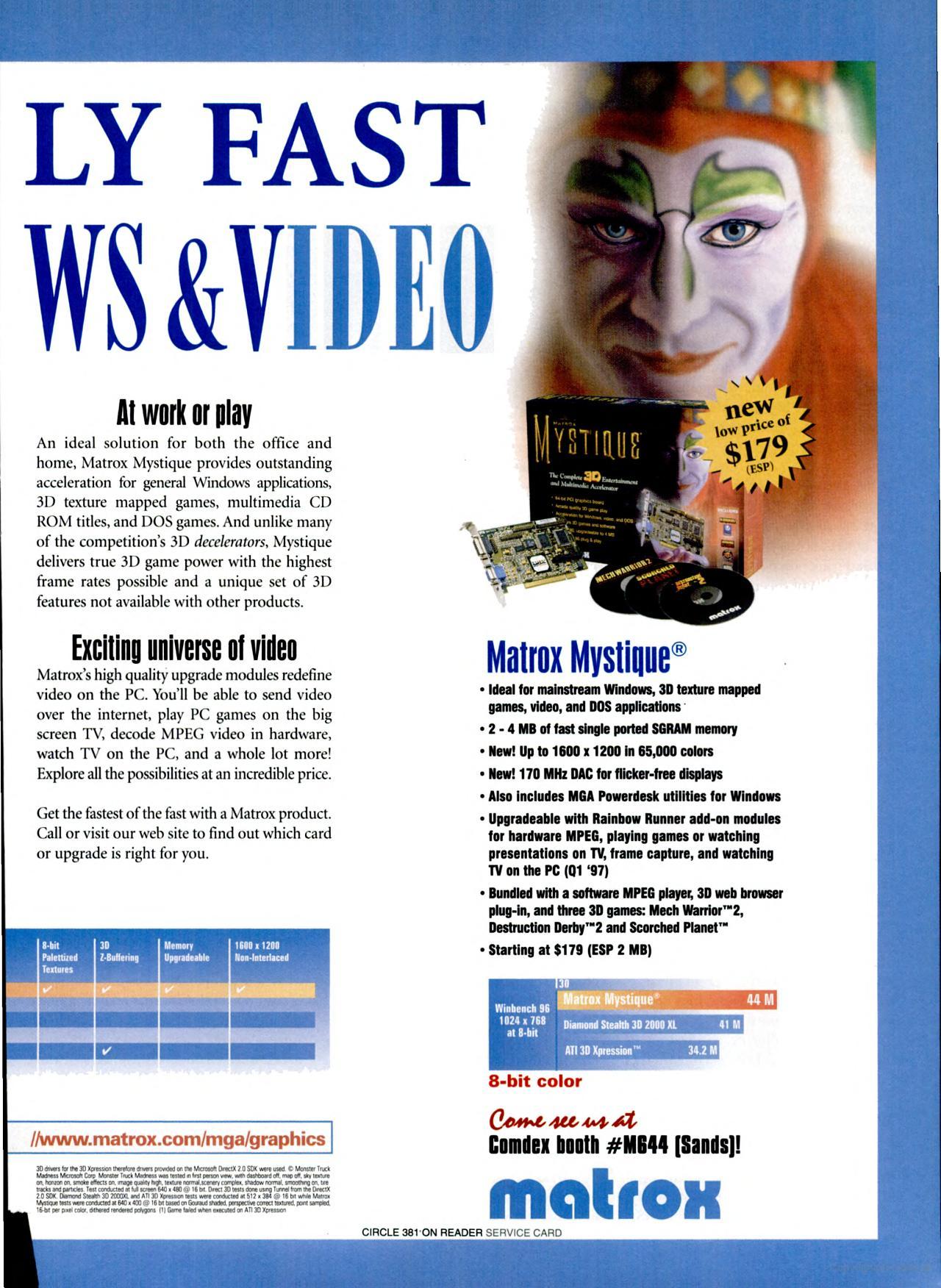
An advert for the Millennium and Mystique, Dec 1996
According to the company at the time, the MGA‑1064SG could process 25 million texels/second where the texels were perspective correct, Gouraud shaded, transparent, Colour Lookup Table 8 expanded to 16‑bit RGB, and Z‑buffered. Game and 3D API support included DirectDraw and Direct3D as well as Criterion’s Renderware.
Mystiques fitted with 4 MB from factory were upgradable to 8 MB. The 8 MB cards from factory simply had the 4 MB memory expansion module fitted. Another option header on the board allowed you to connect the Rainbow Runner - an MPEG-1 and AVI video playback module that included further video input and output ports. A Rainbow Runner TV module added a TV tuner.
Matrox has given us a valiant effort, but because of the Mystique's fatal flaw, the card has already earned the nickname of the "Mistake".
The Mystique is a solid performer with a few key pieces missing. The lack of filtering can be seen as nothing less than a fatal flaw."
NEXT Generation, February 1997
The retail version of Mystique came bundled with three 3D games: MechWarrior 2, Destruction Derby 2 and Scorched Planet. IBM shipped their desktop and mini-tower PC 300PL range with Mystique cards in 1997.
Tip: If you get frequent lock-ups or freezes disable the "Use Bus Mastering" feature under the device driver Settings tab. This Bus Mastering is present on all Mystique models and will increase your frame rates but unfortunately increases instability
Summing up: Mystique had arguably the best 2D quality and performance for a 1996 and even 1997 card. For 3D gaming, performance still beat the early S3 ViRGE and ATI Mach 64 cards though 3D image quality was poorer due to its limited 3D feature set. If you have a 3dfx Voodoo 1 card, use that in conjunction with this for better 3D performance.
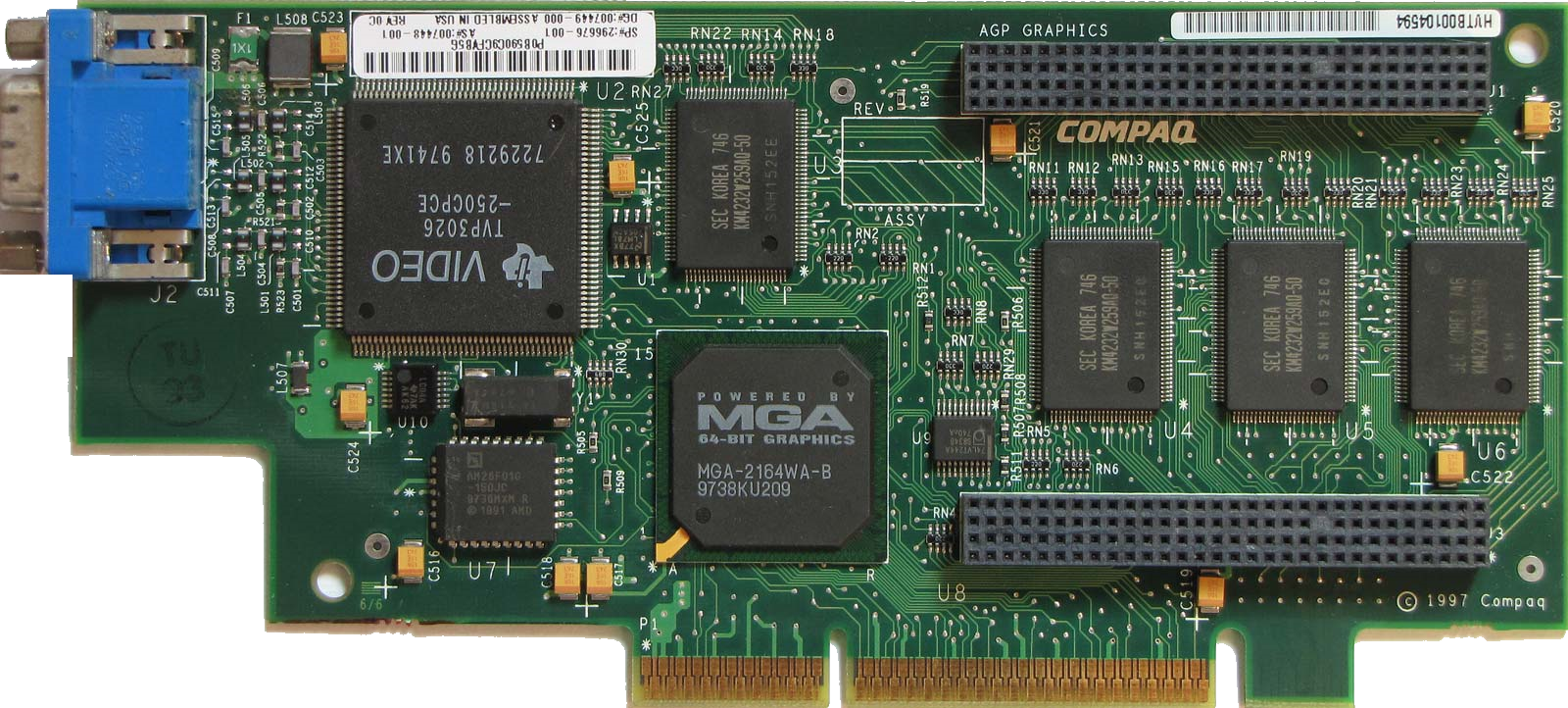 Millennium 2 / Millennium II
Millennium 2 / Millennium II
Launched: 1997
Codename:
164WMistral
Graphics Chip: MGA-2164W or MGA-2164WP-C
Bus: PCI and AGP 1x
Memory: 4 MB WRAM or 8 MB (expandable up to 16 MB)
Ports: 15-pin DSUB
Core Clock Speed:
66 MHz
RAMDAC Speed: 220 or 250 MHz
Product ID: MIL2P/4/220,
MIL2P/4I, MIL2P/4/DELL, MIL2P/8/HP, MIL2P/8/DELL2, MIL2P/4G, MIL2P/4/DELL2
Price: $299 (4 MB), $399 (8 MB), $498 (mid-1997, 16 MB WRAM version)
Introducing faster 2D performance, higher maximum resolution, and a Direct3D-compliant 3D engine thanks to an upgraded version of the Mystique chip, the Millennium II added AGP support, double the video memory capacity (16 MB) and an enhanced RAMDAC.
Despite these upgrades however, it still lacked bilinear filtering just like the 1064SG on Mystique.
It was targeted at the business market.
Key features:
- 62.5 MHz core clock
- 4 MB of fast WRAM (64-bit memory bus width) - expandable in 4, 8 or 12 MB modules that slot into the two long sockets.
Dell shipped their Dimension XPS range with Matrox Millennium II cards in mid-1997, and Compaq did the same on their Pentium II desktops toward the end of that year. US-only PC maker, Quantex also shipped some Pentium II systems with the Millennium II. You could also upgrade a Millennium II card with the Matrox Rainbow Runner Studio, which gave the card video editing, video conferencing, and PC-to-TV capability with hardward MPEG video. In December 1997, PC Magazine ran a comparison of Pentium II desktops for Professional/Enthusiast, and the Matrox Millennium II was considered the best graphics card alongside the Number Nine Revolution 3D.
| Memory Upgrades* (sold separately) | |
| • | 4, 8, or 12 MB memory modules available for increased resolutions, colors, and speed. |
| • | Upgrades sold separately. Video and memory upgrades cannot be used together. |
| Power your PC to the next level of performance - see what memory adds to your card! |
|
| Maximum 2D Resolutions and Colors | ||||
| Colors | 4 MB | 8 MB | 12 MB | 16 MB |
| 256 | 1920 x 1200 | 1920 x 1200 | 1920 x 1200 | 1920 x 1200 |
| 65K | 1920 x 1080 | 1920 x 1200 | 1920 x 1200 | 1920 x 1200 |
| 16.7M | 1280 x 1024 | 1920 x 1080 | 1920 x 1080 | 1920 x 1080 |
| Maximum 3D Resolutions and Colors | ||||
| Colors | 4 MB | 8 MB | 12 MB | 16 MB |
| 65K | 1152 x 864 | 1920 x 1080 | 1920 x 1200 | 1920 x 1200 |
| 16.7M | 800 x 600 | 1152 x 864 | 1280 x 1024 | 1280 x 1024 |
|
||||||||||||||||||||||||||||||||||||||||||||||||||||||||||||||||||||||||||||||||||||
| Resolution | Max. Refresh Rate (Hz) | Max. Colour Depth |
|---|---|---|
| 1600 x 1200 | 75* | 8-bit |
| 1280 x 1024 | 85 | 8-bit |
| 1152 x 864 | 75 | 16-bit |
| 1024 x 768 | 85 | 16-bit |
| 800 x 600 | 85 | 32-bit |
| 640 x 480 | 85 | 32-bit |
*Original Mystique is only able to display 1600 x 1200 at 60 Hz refresh rate.
A Mystique 220 Business version was also released, though this only differed in what bundled software you got.
Tip: If you get frequent lock-ups or freezes disable the "Use Bus Mastering" feature under the device driver Settings tab. This Bus Mastering is present on all Mystique models and will increase your frame rates but unfortunately increases instability
Tip: There have been reports of issues running 3D with motherboards that use the Intel i815 and 440BX chipsets.
Summing Up: Not a great deal of difference from the earlier Mystique, just slightly faster so it's the same message here - great 2D quality and performance for a 1997 card. For 3D gaming, performance still just fractionally beat the latest S3 ViRGE/DX card [also from 1997] with 4 MB on both and ATI Mach 64 cards though 3D image quality was poorer due to its limited 3D feature set. If you have a 3dfx Voodoo 1 card, use that in conjunction with this for better 3D performance.
 Millennium m3D PCX2
Millennium m3D PCX2
Launched: 1997
Graphics Chip: PowerVR PCX2
Bus: PCI v2.1
Memory: 4 MB SDRAM
Ports: None
Price: ?
Known Board Revisions: B
The m3D was a 3D graphics accelerator based around the NEC PowerVR chip. It had 4 MB of onboard RAM. Unlike other cards like the 3dfx Voodoo range, PowerVR did not have a VGA passthrough connector, instead relying on the board's drivers to detect 3D and make use of the card.
One key advantage of the PCX2 chip was that it supported 3D acceleration at up to 1024 x 768 resolutions.
"The m3D is a budget-conscious Quake-head's dream come true. Not only does its GL Quake performance and visual quality rival Voodoo, the m3D also offers the high resolutions and 24-bit color that 3Dfx can only dream of. And sons of Quake, such as Hexen II, look just as gorgeous.", Boot Magazine, December 1997
3D UPGRADE FOR FAST GAME PLAY
Matrox m3D takes you to the outer limits of 3D gaming. Combining high-speed 30 frames/second game play with support for up to 1024 x 768 resolution, Matrox m3D gives you the edge you need to truly enjoy today's Direct3D games. What's more, two 3D games are included: Ultim@te Race (full version) and Hexen IITM: Continent of Blackmarsh (9 level OEM version ). European customers will receive Ultim@te Race (full version) and MDKTM: Mission Laguna BeachTM (OEM version ). Also included are over 20 3D game demos, making it the most cost-effective, full-featured 3D upgrade for your PC.
BLAZING 3D SPEED
Speed is everything. Especially when playing today's action-packed Direct3D games. Matrox m3D turbo-charges your games at over 30 frames per second so you'll get real-time response and hours of non-stop, arcade action.
| GAME | MAXIMUM FRAME RATE @ 640 x 480 |
| Quake | 32 fps |
| Tomb Raider | 60 fps |
| Hexen II | 32 fps |
| Moto Racer | 40 fps |
| Terracide | 45 fps |
HIGH DEFINITION 3D
Bigger is better. With Matrox m3D, you can now play compatible 3D games at up to 1024 x 768 resolution. At this higher resolution, the images in your games will be more clearly defined for a truly immersive and realistic gaming experience.
| Games at 1024 x 768: | ||
| • Quake | • Wipeout XL | • X |
| • Tomb Raider | • Hardcore 4 x 4 | • G-Police |
| • Hexen II | • Terracide | • Organic Art |
ENHANCED 3D IMAGE QUALITY


with standard VGA with Matrox m3D
Matrox m3D works as a companion upgrade to your existing Direct Draw compatible PCI or AGP card with 2MB or more of memory. All you have to do is insert it into an available PCI slot in your PCI or AGP Intel Pentium® system. It's also specially optimized for Matrox Mystique, Mystique 220, Millennium, and Millennium II graphics cards and works with the Matrox Rainbow Runner Studio video editing module.
STATE-OF-THE-ART 3D FEATURES |
|
| FEATURE | BENEFIT |
| PowerVR PCX2 | 3D controller |
| PCI connector | For PCI and AGP systems with compatible PCI slots |
| 4 MB of SDRAM | Memory entirely dedicated to storing texture maps |
| Perspective correct texture mapping | Ensures that textures move with objects when changing angles |
| Bilinear filtering | Enables smooth, realistic surface textures |
| MIP-mapping | Eliminates blocky images when viewed from different distances |
| Fogging | Creates dramatic 'cloud' or 'smoke' effects used in combat games or flight simulators |
| Alpha-blending/transparency | Allows objects to appear in front of each other with varying levels of transparency |
| 32-bit Z-buffer | For increased depth precision and higher performance |
| Gouraud shading | Provides photo realistic shading effects |
| Direct3D support | Supports a wide number of 3D games |
| Full-screen and windowed 3D support | Offers flexible support for today's varying 3D games |
More Images
 Millennium G200
Millennium G200
Launched: 1998
Codename: G200A D2
Graphics Chip: MGA-G200
Bus: AGP 1x v1.0 (3.3V only)
Memory: 8 MB SGRAM (upgradable to 16 MB)
Ports: 15-pin DSUB
Core Clock Speed: 85 MHz
RAMDAC Speed: 250 MHz
Product ID: MGI-G2-DUALP-PL, MGA-G200A
G200 was Matrox’s first fully AGP-compliant graphics processor. While the earlier Millennium II featured AGP, it did not support the full AGP feature set. The G200 took advantage of DIME (Direct Memory Execute) to speed texture transfers to and from main system RAM. That allowed the G200 to use system RAM as texture storage if the board's local RAM was of insufficient size for the task at hand. G200 was one of the first cards to support this feature.
It came with an excellent 2D core, something that Matrox were famous for. The 3D core was not as fast as 3dfx Voodoo2, but in most cases it offered a significantly better image quality. 32-bit color rendering and a 32 bit Z-buffer are the ones responsible for that besides a lot of other nice features.
The key thing that caused potential G200 buyers to instead plum for an nVidia RiVA TNT or 3dfx Voodoo3 was the Matrox card's lack of OpenGL support. Matrox promised this was coming, but failure to have this ready at launch was enough to cause the G200 to flop. OpenGL support was critical in these days, as every 3D game was using it. Matrox was trying to please both the business user and the hard core gamer, which turned out to be a mistake.
Integrated Solution - The G200 offers both 2D and 3D acceleration. Matrox has almost always provided the fastest 2D cards on the market and the G200 raises the bar once again.
Good Performance - Direct3D tests we've seen put it on par with Voodoo 2. OpenGL tests remain to be seen.
Decent Price - Boards should cost as little as $150 in 8MB configurations.
Excellent Image Quality
Cons
Matrox has a rocky track record; the Mystique suffered from very poor 3D performance.
On The Horizon
There is current no information regarding Matrox's next generation of chips."
PC Accelerator, Issue 1 September 1998
Unlike most other vendors here, Matrox offers an array of add-ons - TV tuner ($150), DVD decoder ($80), video-editing daughterboard ($80), and digital flat-panel connector ($50) - so you can change the Millennium as your needs evolve. The more expensive Marvel includes an integrated TV tuner and TV-out capabilities, and it accepts most of the same options as the Millennium. A slick external cable box for the tuner eliminates the need to hunt behind the PC when attaching a digital camera, VCR, camcorder, or cable TV lead. We found the Marvel's on-monitor TV quality fine; the color was well saturated and the picture almost as sharp as a dedicated TV set. The tuner is controlled via a virtual remote control with easy access to picture adjustments.
Both cards share a common installation routine and most driver features. We had no problems setting up either one, and Matrox's interface offers a robust array of controls for customizing monitor settings and the Windows desktop. The Marvel has additional controls for its multimedia tools, plus a setup utility that walks you through configuring and testing the video ports and cabling. The manuals are clear, and there's quick-start guide for setting up the Marvel's more elaborate cabling.
When it comes to 3-D performance, the Matrox chip is a step behind the newer offerings from nVidia and 3Dfx. Results were in the middle of the pack. The chip also registered some minor quality flaws involving certain MIP-mapping, texture rasterization, and geometry rasterization features. But our test games played without any discernible artifacts or jittery screens, and games seemed particularly vivid - possibly enhanced by Matrox's new Vibrant Color Quality (VCQ) technique. The 2-D test scores were better, negligibly behind those of the leaders, and the Video Bandwidth results (an indicator of signal quality) were among the best we've measured.
The Marvel's software bundle is excellent, and includes Ulead Photo Express 2.0, Ubi Soft's Tonic Trouble, and a trial version of VDO-Phone Internet Trial. In addition, the bundle includes the new Avid Cinema video editing software, a joint effort between Avid and Matrox.
Generally, the Marvel and Millennium are stocked with features and software well suited for their intended markets. For the price, we wish the Marvel delivered better 3-D performance. For business users interested in a solid 2-D card with good enough 3-D and room to grow, the Millennium is an excellent choice."
PC Magazine, 1st December 1998
Whilst the Millennium G200 was the higher-end version equipped with 8 MB SGRAM, the Mystique G200 used slower SDRAM but added a TV-out port. Sadly the G200s were released just shortly before a new generation of cards were launched by ATI and nVidia (RIVA TNT), which both completely outperformed the G200 range.
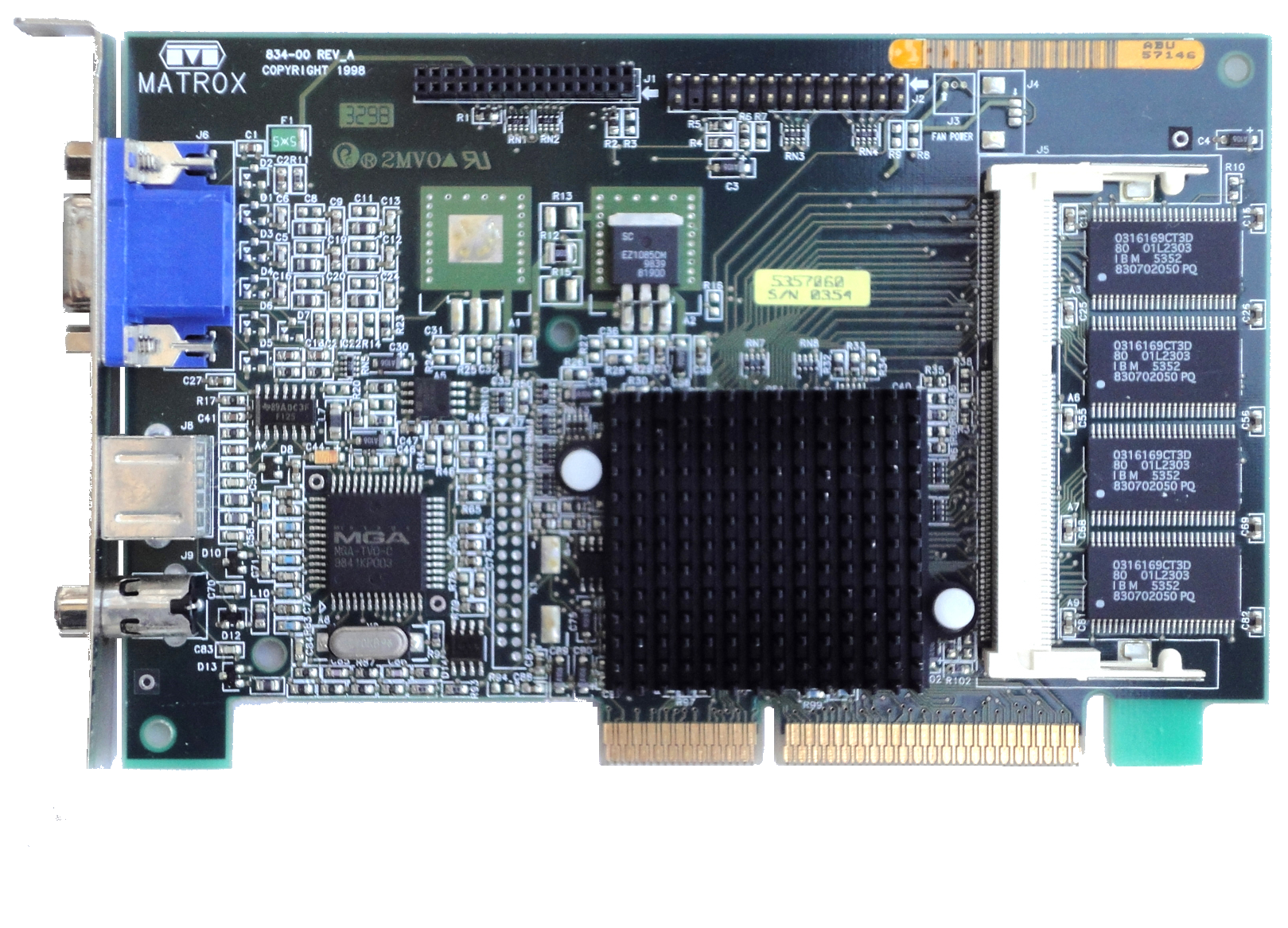 Mystique G200
Mystique G200
Launched: 1998
Graphics Chip: MGA-G200
DAC: 230 MHz
Bus: AGP 1x
Memory: 8 MB SDRAM (upgradable to 16 MB)
Ports: 15-pin DSUB and RCA TV out port
Part #:
Price: ?
The G200 from Matrox (found in both the G200 Mystique and G200 Millennium) was developed as a pretty fast 3D chip that offered very good 3D image quality. It came with an excellent 2D core, something that Matrox were famous for. The 3D core was not as fast as Voodoo2, but in most cases it offered a significantly better image quality. 32-bit color rendering and a 32 bit Z-buffer are the ones responsible for that besides a lot of other nice features.
Whilst the Millennium G200 was the higher-end version equipped with 8 MB SGRAM, the Mystique G200 used slower SDRAM but added a TV out port. Sadly the G200s were released just shortly before a new generation of cards were launched by ATI and nVidia, which both completely outperformed the G200 range.
The G200's potential was severely hurt by Matrox's inability to release a high performing OpenGL driver upon the launch of the chip - something that nVidia already had with their TNT card. This shortcoming was eliminated when they brought out the G400 in 1999.
Key Features:
- MGA-G200 128-bit DualBus graphics chip
- Most powerful all-around video card with full AGP 2X support featuring Symmetrical Rendering Architecture
- Advanced 2D, 3D and software DVD video acceleration (Software DVD player not included)
- Vibrant Color Quality 3D rendering engine for stunning image quality
- High speed 250 MHz RAMDAC for fast refresh rates
- Support for high resolutions and colors
- Games to TV output at 1024 x 768 resolution blows the competition away
- 8 MB of SDRAM memory upgradeable to 16 MB
- Most comprehensive family of multimedia upgrades
- Includes three free software titles: Motorhead, Incoming, and Tonic Trouble ...plus 3D game demos
The Mystique G200 had a number of optional upgrades, including:
- 8 MB SDRAM memory module for a total of 16 MB of memory
- Rainbow Runner G-Series, the award-winning product featuring video editing, TV on the PC, PC-VCR and more
- Hardware DVD module for the highest quality MPEG-2 video playback
 Millennium G200 Quad
Millennium G200 Quad
Launched: 1998
Graphics Chip: MGA-G200
Bus: PCI
Memory: 8 MB SGRAM per channel (max 32 MB per board)
Ports: DVI Out
Part #:
Price: ?
This card is a "dual-head" card but using the provided cables you can display on four separate monitors. The MGA-G200 graphics chip can support 2 or 4 analog or digital outputs per single PCI board. With several of these cards, you can display up to 16 monitors from a single system!
Maximum resolution per channel is 1920 x 1200 @ 16bpp @ 70 Hz, 1600 x 1200 @ 24bpp @ 85 Hz or 1280 x 1024 with digital flat panel monitors.
For Windows, this uses G200 MMS drivers supported under Windows® XP, Windows® 2000, Windows® Me, Windows® NT®4.0, and Windows® 98. Minimum system requirements are PCI bus motherboard, Pentium 133+ with 32 MB RAM, Windows 98, XP, 2000 or NT 4.0.
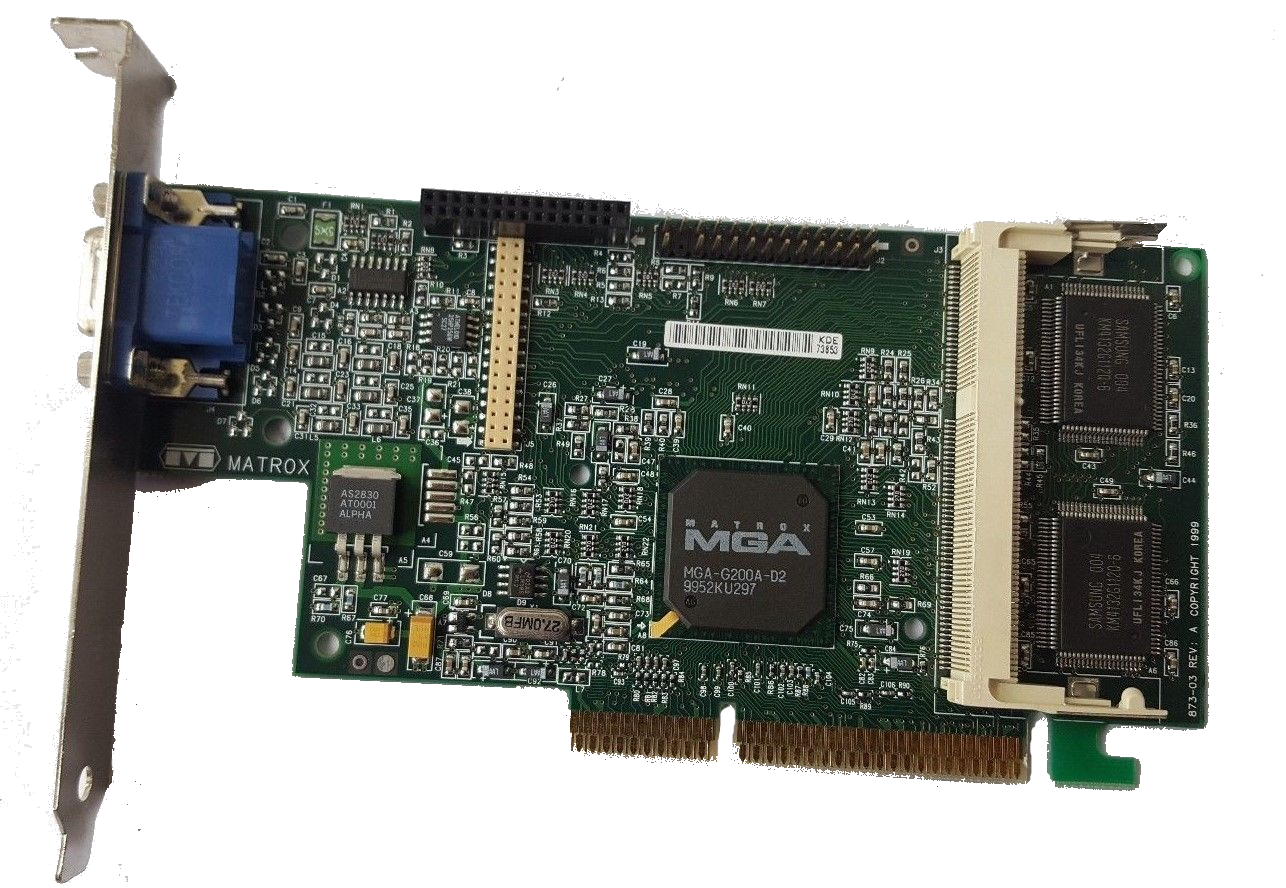 Millennium G250
Millennium G250
Launched: 1998
Bus: AGP 1x
Memory: 16 MB
Part #: 5064-9191
Ports: 15-pin DSUB
Price: ?
Onboard memory can be expanded using the SODIMM slot.
This card was OEM'd to Compaq (part #358231-005) - the memory expansion slot was removed and it came with 8 MB onboard memory only.
 Millennium G400
Millennium G400
Launched: 1999
Bus: AGP 1x, 2x or 4x
Memory: 16 MB or 32 MB SGRAM
Core Clock Speed: 125 MHz
Memory Speed: 166 MHz DRAM (128-bit)
RAMDAC Speed: 300 MHz
(main display), 135 MHz (secondary display)
Part #: 5064-9194 Dual Head MDHA/16/0E5, G4+ MDH4A16G, G4+ MDH4A32G
Price: $149 (16 MB), $199 (32 MB)
Board Revisions: 202C, 204A, 304, 401, 401A, 402B, 403.
The Millennium G400, codenamed "Toucan", was considered very competitive for its time, especially with DirectX games. As per previous Matrox cards, it had an incredibly crisp image quality. It also supported the now common single-pass multi-texture rendering, meaning 2 textures in a single clock cycle. The base G400 could achieve a peak fill rate of 250 Mtexel/sec (calculated by taking the core clock and multiplying it by 2).
The 32 MB version has four additional memory chips on the rear side of the board. Cards that have part numbers containing SH or DH indicate single head or dual head. Part numbers with OE indicate they were for the OEM market.
The G400's AGP connector provides both the older 3.3V and newer 1.5V keys, meaning it will work happily in an AGP version 1.0 (3.3V) or version 2.0 (1.5V) motherboard slot. If used in an AGP v1.0 slot it will run at either 1x or 2x speed. If used in an AGP v2.0 slot it can run at up to 4x speed.
It supports the following SVGA and up graphics modes:
| Resolution | Max. Refresh Rate (Hz) | Max. Colour Depth |
|---|---|---|
| 2048 x 1536 | 70 | ? |
| 1920 x 1440 | 75 | ? |
| 1920 x 1200 | 90 | ? |
| 1920 x 1080 | 100 | ? |
| 1800 x 1440 | 80 | ? |
| 1600 x 1200 | 100 | ? |
| 1600 x 1024 | 120 | ? |
| 1280 x 1024 | 120 | ? |
| 1280 x 720 | 160 | ? |
| 1152 x 864 | 140 | ? |
| 1024 x 768 | 160 | ? |
| 856 x 480 | 200 | ? |
| 800 x 600 | 200 | ? |
This card shown is a "dual-head" card (2 x 15-pin DSUB connectors) to operate dual monitors for Windows in extended desktop mode or to duplicate the same image on each monitor. The G400 was also available in single output form, which no doubt was slightly cheaper to buy.
Here's what a review at the time had to say:
"The G400 is finally here, and it is definitely not a Voodoo3 or TNT2 killer. The hard core gamer that simply wants performance will probably want to stay away from the G400, however if you don't mind not having the absolute best in 3D performance then the G400 quickly becomes a viable option.
Owners of slower computers will want to stay away from the G400, instead you'll probably want to explore 3dfx's solutions, or maybe NVIDIA's TNT2 depending on how "slow" your computer happens to be (in terms of CPU speed). Mid range systems should be fine with the G400, however don't expect eyebrow raising performance out of the card, even the MAX version. Higher end systems will prove to close the gap between the G400 and the more performance oriented alternatives; the G400 has some room to grow, so the faster your CPU, the better your G400 will perform, that's a given.
Matrox definitely has a winner on their hands. The G400 is much more than everything the G200 should have been, and it's no surprise that such a combination of features, performance, and outstanding image quality will be making its way into the hands of quite a few anxious users that have renewed faith in Matrox, myself included ;) Let's just hope that Matrox can iron out the last few bugs with their OpenGL driver, and work on improving performance. Although the G400 will probably never reach TNT2 Ultra levels of performance".
Tip: Matrox released the Matrox Tweak Utility in late 1999. This allows you to toggle V-Sync and also overclock the card. The core and memory are always locked together, so the overclock which is specified in %, will impact both by the same percent. The tool will store each overclock setting for each resolution.
Similar performance to ATI's Rage 128 Pro, nVidia's Riva TNT2 and 3dfx Voodoo 3 2000.
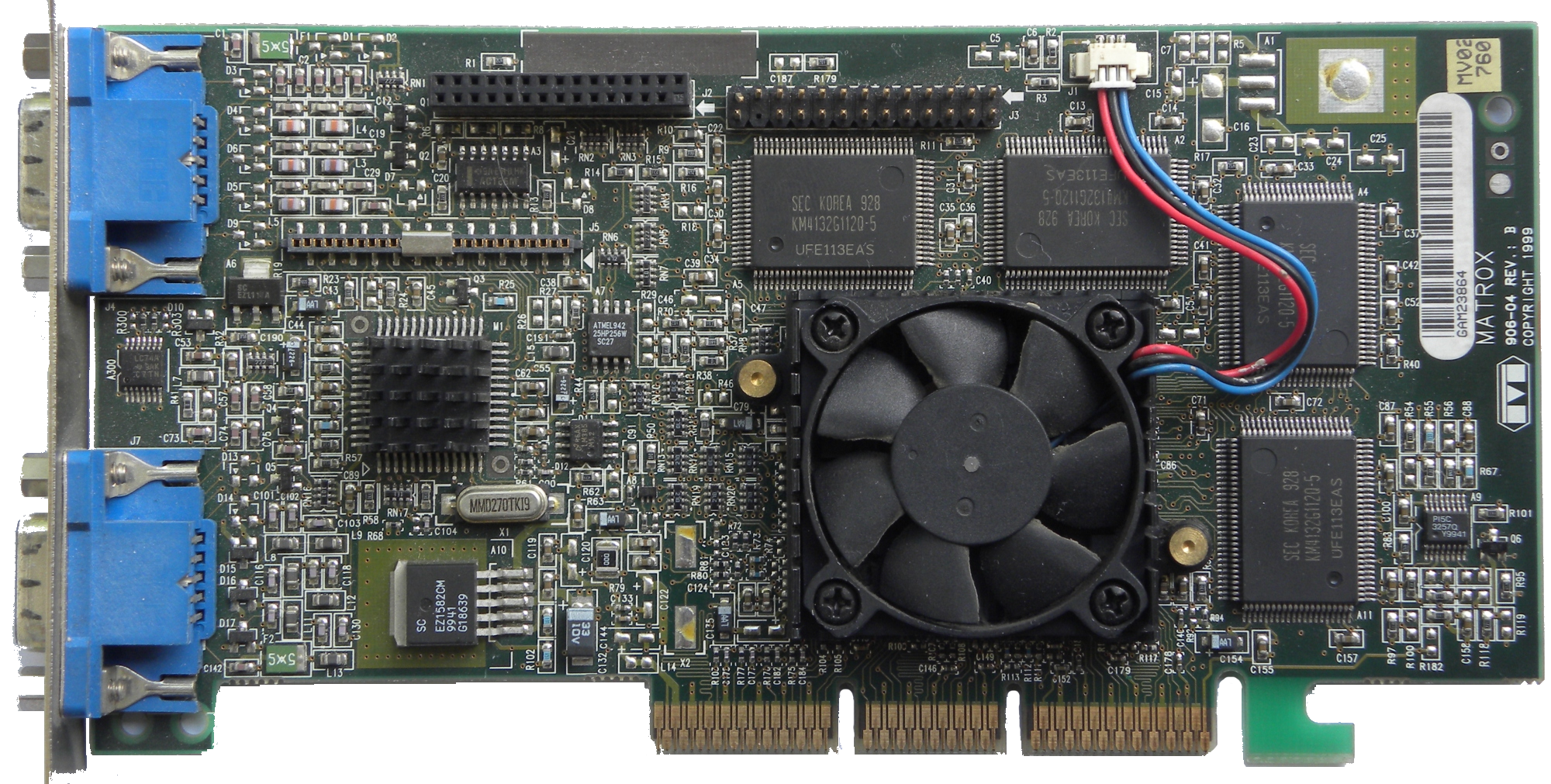 Millennium G400 Max
Millennium G400 Max
Launched: 1999
Bus: AGP 1x, 2x, or 4x
Core Clock Speed: 166 MHz
Memory: 32 MB only
Memory Speed: 200 MHz SGRAM (128-bit)
RAMDAC Speed: 360 MHz
(main display),135 MHz (secondary display)
Price: $249, £145 ex.VAT (Dec 1999)
Known Board Revisions: A, B
The souped-up Millennium G400 Max, with faster core clock speed, faster memory and a faster RAMDAC. It supports resolutions up to 1600 x 1200 at 24-bit colour depth, but fails to better the faster 3dfx Voodoo 3 3000 or nVidia Riva TNT2. It is fully compatible with DirectX 6.0 and OpenGL. Due to the faster speed, the G400 Max comes with a fan on top of the heatsink whereas the original G400 was passively cooled (heatsink only).
Note the two VGA outputs, which were almost a trademark of many Matrox cards of the era - this allowed you to run Windows in split screen/extended desktop mode. The topmost DSUB header is for the "main" monitor. I don't believe the G440 Max also got a single output version, like the original G400 had.
The G400 Max's AGP connector provides both the older 3.3V and newer 1.5V keys, meaning it will work happily in an AGP version 1.0 (3.3V) or version 2.0 (1.5V) motherboard slot. If used in an AGP v1.0 slot it will run at either 1x or 2x speed. If used in an AGP v2.0 slot it can run at up to 4x speed.
It supports the following SVGA and up graphics modes:
| Resolution | Max. Refresh Rate (Hz) | Max. Colour Depth |
|---|---|---|
| 2048 x 1536 | 85 | ? |
| 1920 x 1440 | 85 | ? |
| 1920 x 1200 | 100 | ? |
| 1920 x 1080 | 110 | ? |
| 1800 x 1440 | 85 | ? |
| 1600 x 1200 | 100 | 24-bit |
| 1600 x 1024 | 120 | ? |
| 1280 x 1024 | 120 | ? |
| 1280 x 720 | 160 | ? |
| 1152 x 864 | 140 | ? |
| 1024 x 768 | 160 | ? |
| 856 x 480 | 200 | ? |
| 800 x 600 | 200 | ? |
 Millennium G450 AGP
Millennium G450 AGP
Launched: 2000
Codename: Condor
Bus: AGP 1x, 2x or 4x
Memory: 16 MB, 32 MB DDR
Memory Speed: 166 MHz
Core Clock Speed: 124 MHz
RAMDAC Speed: 360 MHz
Part #: G45+MDHA16D, G45+MHDA16LXB, G45+MHDA16DLXB, G45+MDHA32DCPQF
 "Powered by the highly integrated Matrox G450 chip, the Millennium G450 is a feature-rich, future-proof business accelerator. Built to blaze trails in the worlds of productivity and multitasking, it offers the corporate market a host of features, such as third-generation DualHead® display technology, including eDualHead(TM), and Matrox's trademark ultra-crisp image quality. The Millennium G450 also doubles as a well-rounded home entertainment solution. In addition to 2D, 3D, and DVD acceleration, it comes equipped for DualHead gaming, 3D Environment-Mapped Bump Mapping, and TV output."
"Powered by the highly integrated Matrox G450 chip, the Millennium G450 is a feature-rich, future-proof business accelerator. Built to blaze trails in the worlds of productivity and multitasking, it offers the corporate market a host of features, such as third-generation DualHead® display technology, including eDualHead(TM), and Matrox's trademark ultra-crisp image quality. The Millennium G450 also doubles as a well-rounded home entertainment solution. In addition to 2D, 3D, and DVD acceleration, it comes equipped for DualHead gaming, 3D Environment-Mapped Bump Mapping, and TV output."
The image above shows the 16 MB variant, with two large memory chips above and to the right of the main graphics core. The 32 MB variant has four memory chips, two in each of these locations.
Key features:
- 0.18-micron technology
- AGP 1X, 2X, 4X (tolerant with older mobos)
- 360 MHz RAMDAC
- 16MB or 32MB DDR memory
- Support for OpenGL and DirectX
- 256-bit DualBus
- DualHead display technology
- Vibrant Color Quality² rendering
- Environment-Mapped Bump Mapping
- UltraSharp DAC
- Integrated TV encoder
- High-quality DVD playbacks
The G450 AGP connector is "Universal", meaning it is able to also work with older motherboards that only have AGP version 1.0 (1x or 2x). When fitted to such an AGP slot, the card will run its core clock at ~60 MHz and its memory at ~150 MHz. If fitted to a motherboard with an AGP version 2.0 slot, it can run at its full 4x speed.
G450 vs G400 Product Comparison Chart
| Products | Millennium G450 Series | Millennium G400 Series |
| Technical specifications | ||
| Graphics chip | Matrox G450 based on Matrox G400 technology |
Matrox G400 256-bit DualBus |
| Built-in memory | 16 MB SDR*, 16 MB DDR, or 32 MB DDR | 16 MB SDR or 32 MB SDR |
| Memory upgrade | Fixed memory | Fixed memory |
| Bus type | AGP 1X/2X/4X or PCI** | AGP 1X/2X/4X |
| RAMDAC | Up to 360 MHz primary and 230 MHz secondary | Up to 360 MHz |
| * 16MB SDR available on G450 LE ** G450 PCI is recommended for systems based on Intel chipsets. Feature and performance support for systems based on non-Intel chipsets is limited. |
||
| 2D/3D Resolutions | ||
| Max. 2D resolutions | 2048 x 1536 | 2048 x 1536 |
| Max. 3D resolutions | 2048 x 1536 | 2048 x 1536 |
| 3D support | ||
| 3D engine | New 3D rendering array processor | New 3D rendering array processor |
| Hardware accelerated 3D features | Same features as G400 | Vibrant color quality2,Environment mapped bump mapping, and trilinear filtering |
| Video features | ||
| Supports software | MPEG-2 video | MPEG-1 video |
| Supports software DVD video | ||
| Motion Video Rendering (MVR) architecture | ||
| Versatility | ||
| Multiple monitor support | Same features as G400 | DualHead Display supports a second RGB, TV or Flat Panel monitor with one card |
| Drivers | ||
| Supported operating systems | Windows 95, 98, NT 4.0, 2000, Me, OS/2 Warp, and Linux |
Windows 3.1x, 95, 98, 2000, Me, NT 3.51, 4.0, OS/2 Warp, and Linux |
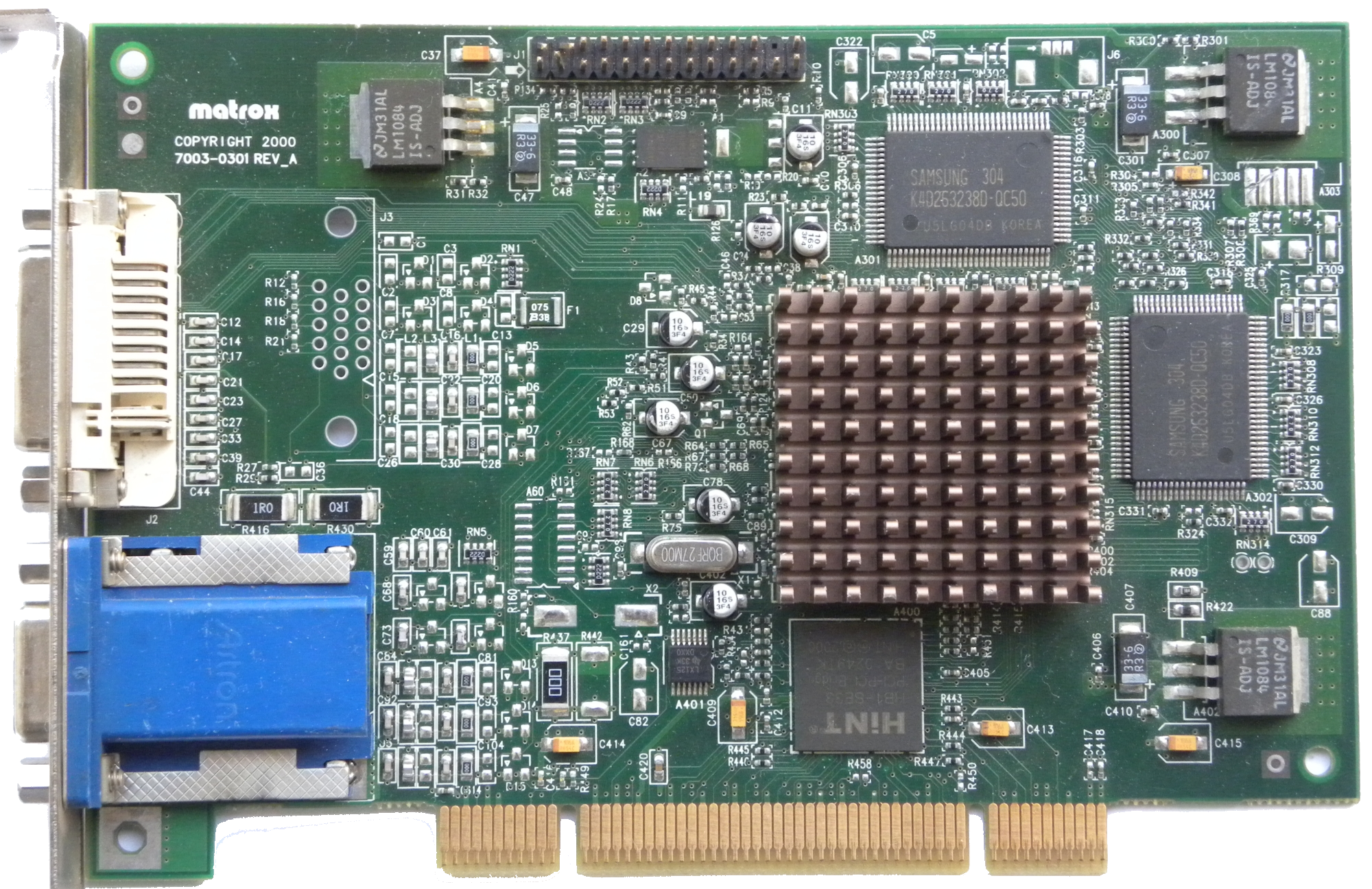 Millennium G450 PCI
Millennium G450 PCI
Launched: 2000
Codename: Condor
Graphics Chip: MGA-G450
Bus: PCI
Memory: 16 MB or 32 MB DDR RAM
Core Clock Speed: 124 MHz
RAMDAC Speed: 360 MHz
"Powered by the highly integrated Matrox G450 chip, the Millennium G450 is a feature-rich, future-proof business accelerator. Built to blaze trails in the worlds of productivity and multitasking, it offers the corporate market a host of features, such as third-generation DualHead® display technology, including eDualHeadTM, and Matrox's trademark ultra-crisp image quality. The Millennium G450 also doubles as a well-rounded home entertainment solution. In addition to 2D, 3D, and DVD acceleration, it comes equipped for DualHead gaming, 3D Environment-Mapped Bump Mapping, and TV output."
Key features:
- 0.18-micron technology
- PCI bus
- 360 MHz RAMDAC
- 32MB DDR memory
- Support for OpenGL 1.1 and DirectX 6
- 256-bit DualBus
- DualHead display technology
- Vibrant Color Quality² rendering
- Environment-Mapped Bump Mapping
- UltraSharp DAC
- Integrated TV encoder
- High-quality DVD playbacks
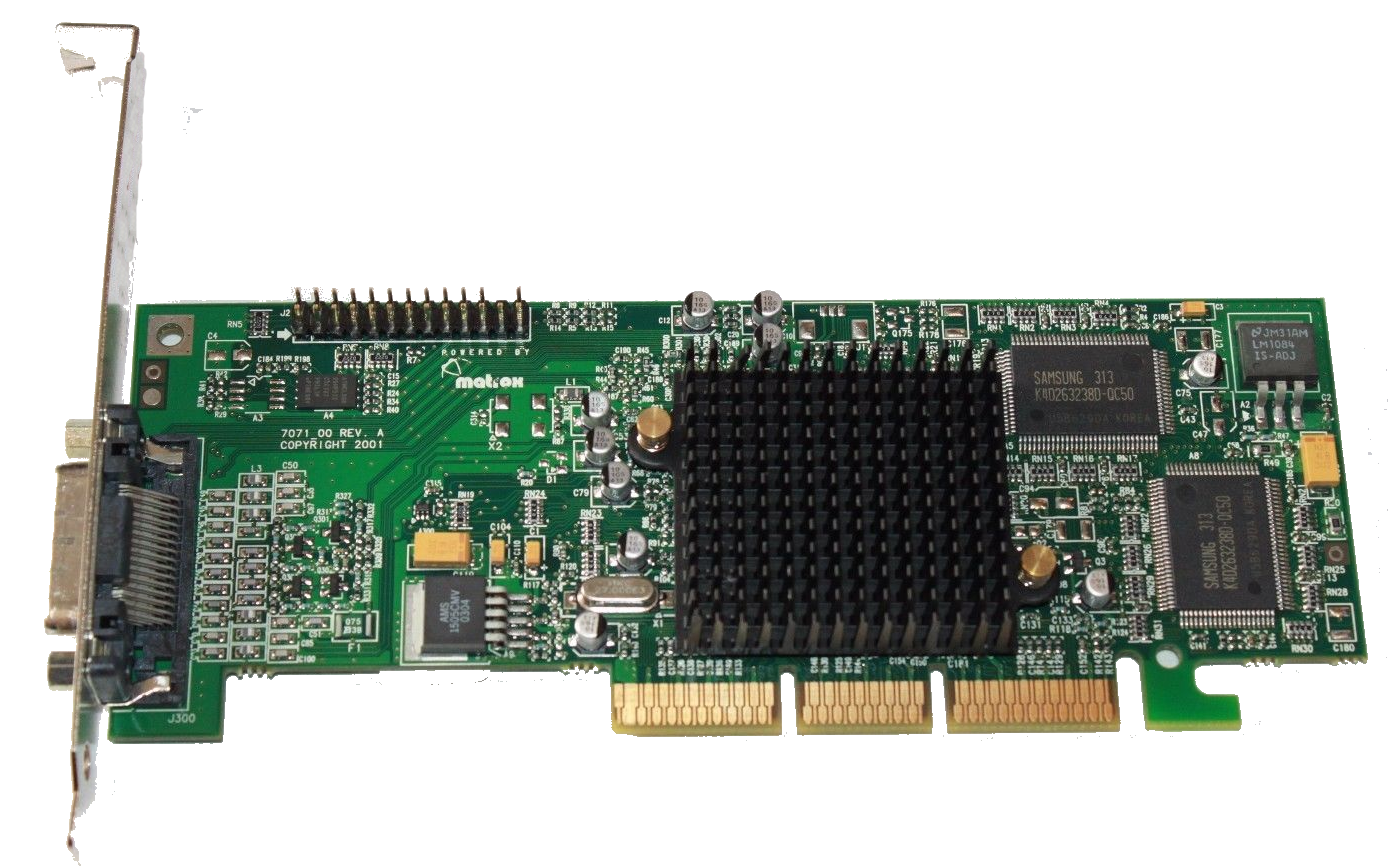 Millennium G550
Millennium G550
Launched: 2001
Codename: G550
Bus: AGP 4x/8x
Memory: 32 MB 64-bit DDR SDRAM
Part #: G55MDDAP32DB
Ports: DVI out
Core Clock Speed: 132 MHz
Memory Clock Speed: 330 MHz (166 MHz each)
Product ID: MGIG55MDDLP32DRF, MGI-G55MDDLP32DR
RAMDAC Speed: 360 MHz
Price: $125
The G550 is a low profile card suitable for shallow desktop or micro-tower units.
 With 32 MB of Double Data Rate (DDR) memory, a 360 MHz primary RAMDAC, and a unique HeadCasting™ Engine accelerating 3D online communication, the Millennium G550 is a titan among graphics cards with trendsetting appeal for the business and home entertainment markets. Comprising an extensive feature set including third-generation DualHead® display capabilities, outstanding 2D performance, and DVI-I support, the Millennium G550 delivers exceptional graphics performance and product stability and ignites a new trend in online communication.
With 32 MB of Double Data Rate (DDR) memory, a 360 MHz primary RAMDAC, and a unique HeadCasting™ Engine accelerating 3D online communication, the Millennium G550 is a titan among graphics cards with trendsetting appeal for the business and home entertainment markets. Comprising an extensive feature set including third-generation DualHead® display capabilities, outstanding 2D performance, and DVI-I support, the Millennium G550 delivers exceptional graphics performance and product stability and ignites a new trend in online communication.
Key features:
![]() Matrox G550 chip
Matrox G550 chip
![]() 32 MB high-speed Double Data Rate (DDR) memory
32 MB high-speed Double Data Rate (DDR) memory
![]() UltraSharp 360 MHz RAMDAC
UltraSharp 360 MHz RAMDAC
![]() World's best 2D graphics solutions
World's best 2D graphics solutions
![]() World's best image output quality
World's best image output quality
![]() Third-generation DualHead® technology including eDualHead™ browser enhancements
Third-generation DualHead® technology including eDualHead™ browser enhancements
![]() DVI and Dual DVI* support
DVI and Dual DVI* support
![]() True multi-display support under the Microsoft® Windows® 2000 operating system
True multi-display support under the Microsoft® Windows® 2000 operating system
![]() Explosive Windows desktop acceleration
Explosive Windows desktop acceleration
![]() High Quality DVD-Playback
High Quality DVD-Playback
![]() HeadCasting™ Engine for hardware-accelerated 3D facial animation
HeadCasting™ Engine for hardware-accelerated 3D facial animation
![]() Bundled HeadCasting™ software for 3D communication
Bundled HeadCasting™ software for 3D communication
![]() Unified and WHQL-certified drivers
Unified and WHQL-certified drivers
![]() Extensive OS support including Windows® 2000, Windows XP, and Linux
Extensive OS support including Windows® 2000, Windows XP, and Linux
![]() Optimized for latest Intel Pentium III, Pentium 4, AMD Athlon, and AMD Duron platforms
Optimized for latest Intel Pentium III, Pentium 4, AMD Athlon, and AMD Duron platforms
| G550 vs competition | ||||||||||||||||||||||||||||||||||||||||
|
It was OEM'd by Compaq as part #313435-001.
 Millennium G550 Dual Monitor
Millennium G550 Dual Monitor
Launched: 2001
Codename: G550
Bus: AGP 4x/8x
Memory: 32 MB
Part #: ?
Ports: Proprietary with breakout cable into 2 x 15-pin DSUB.
Price: ?
This card is a low profile card suitable for shallow desktop or micro-tower units.
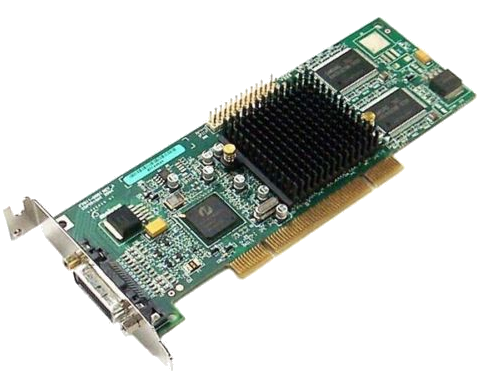 Millennium G550 PCI
Millennium G550 PCI
Launched: 2001
Codename: G550
Bus: PCI
Memory: 32 MB
Part #: G55MDDAP32DBF (low profile) or
Ports: 1 x DMS-59 (DVI) output and adaptor cable with 2 VGA/DSUB connectors
Price: ?
The low profile card is suitable for shallow desktop or micro-tower units.
Max digital resolution 1280 x 1024 in two-monitor operation
ideal for professional digital 2-monitor operation
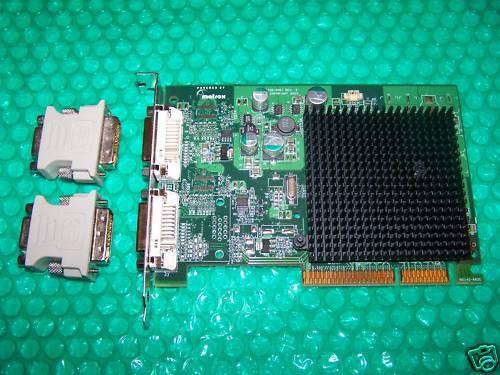 Millennium P650 Dual Head
Millennium P650 Dual Head
Launched: 2002
Graphics Chip: P650
Bus: AGP 4x/8x
Memory: 64 MB
Part #: P65-MDDA8X64 (dual head)
Ports: 2 x DVI out
Price: ?
Full "DualHead" support for using 2 digital or analog monitors at a time.
Millennium P650 Low Profile
 Launched: 2002
Launched: 2002
Graphics Chip: P650
Bus: AGP 4x/8x
Memory: 64 MB
Part #: P65-MDDAP64F (dual head), P65-MDDAP64 (single head)
Ports: 1 x DVI out to 2 DVI out cable + DVI-to-VGA converter.
Price: ?
The P65-MDDAP64F has full "DualHead" support for using 2 digital or analog monitors at a time.
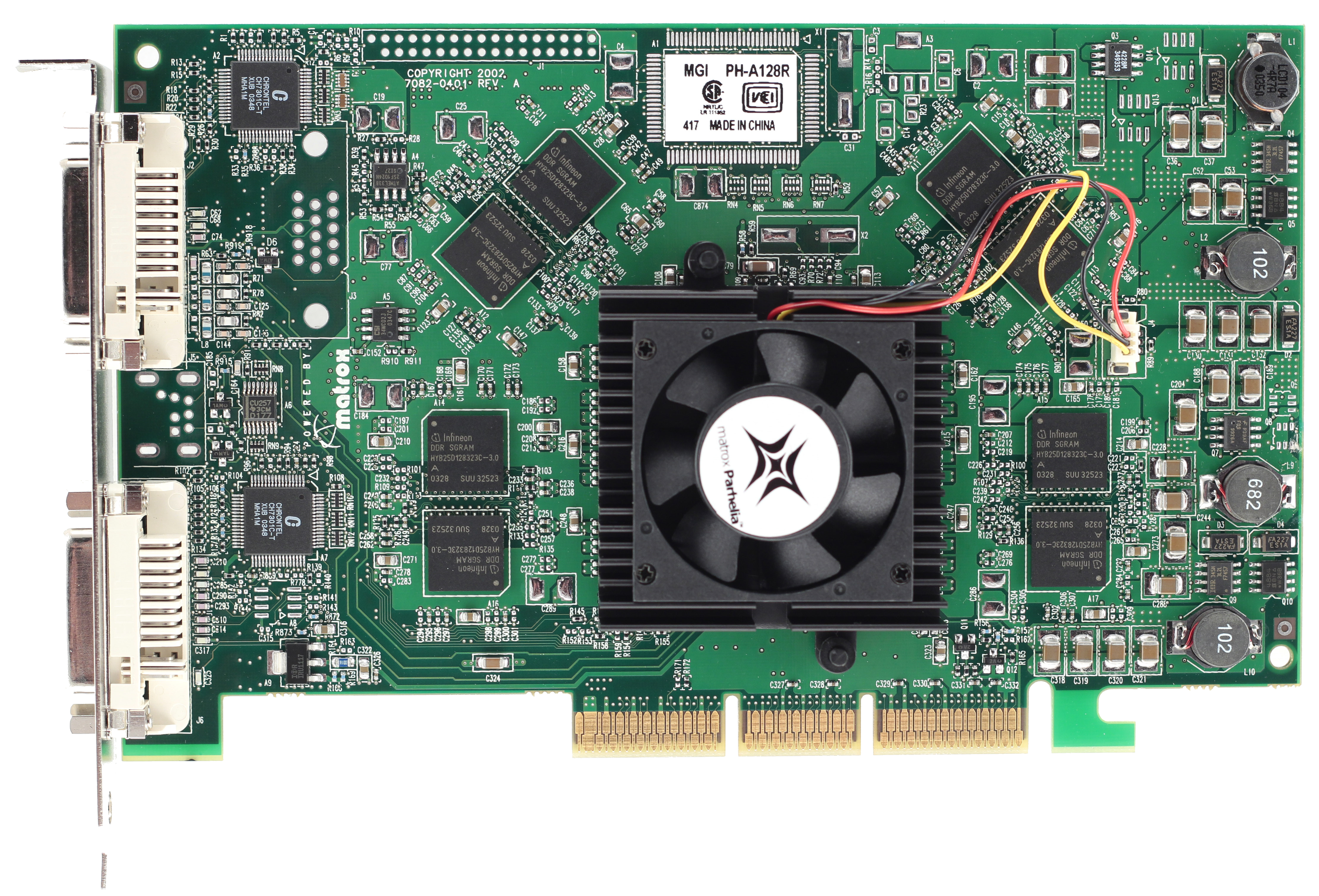 Parhelia Triple Monitor / Parhelia 512
Parhelia Triple Monitor / Parhelia 512
Launched: 2003
Chipset:
Matrox Parhelia PH-A128R
Bus: AGP 4x/8x
Memory: 128 MB
Part #: ?
Ports: 2 x DVI out.
Max. Resolutions: 1-2 digital monitors: 1920 x 1200, 1-2 analog monitors: 2048 x 1536, 3 analog monitors: 1280 x 1024.
Price: ?
Matrox TripleHead could use three* analog monitors at a time (in "independent" or "stretched" mode).
Matrox DualHead could use two digital or analog monitors at a time (in "independent" or "stretched" mode).
The Joined graphics card mode enables an additional Matrox DualHead** or TripleHead† graphics solution to work in tandem in one system to drive up to four displays.
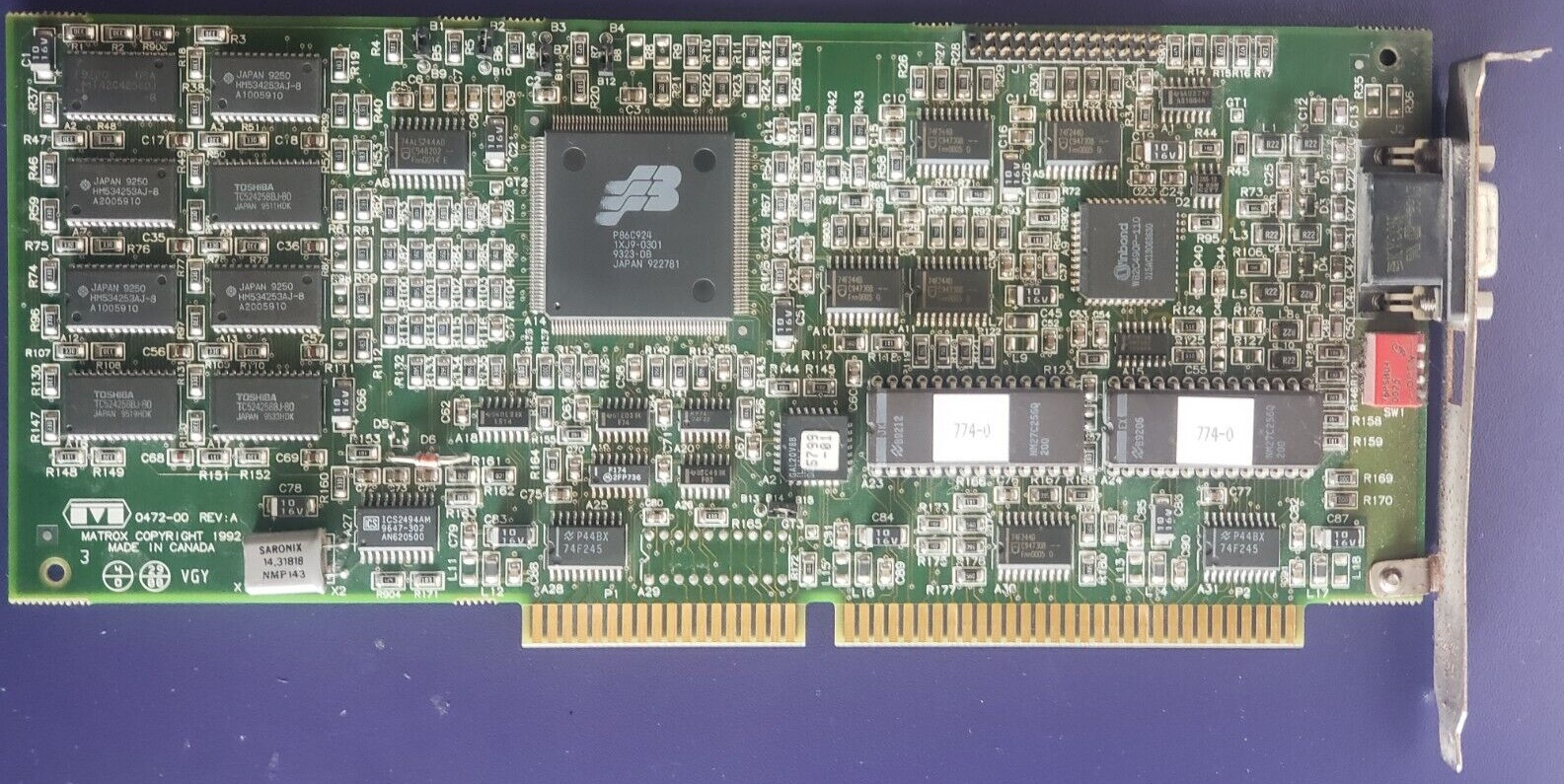
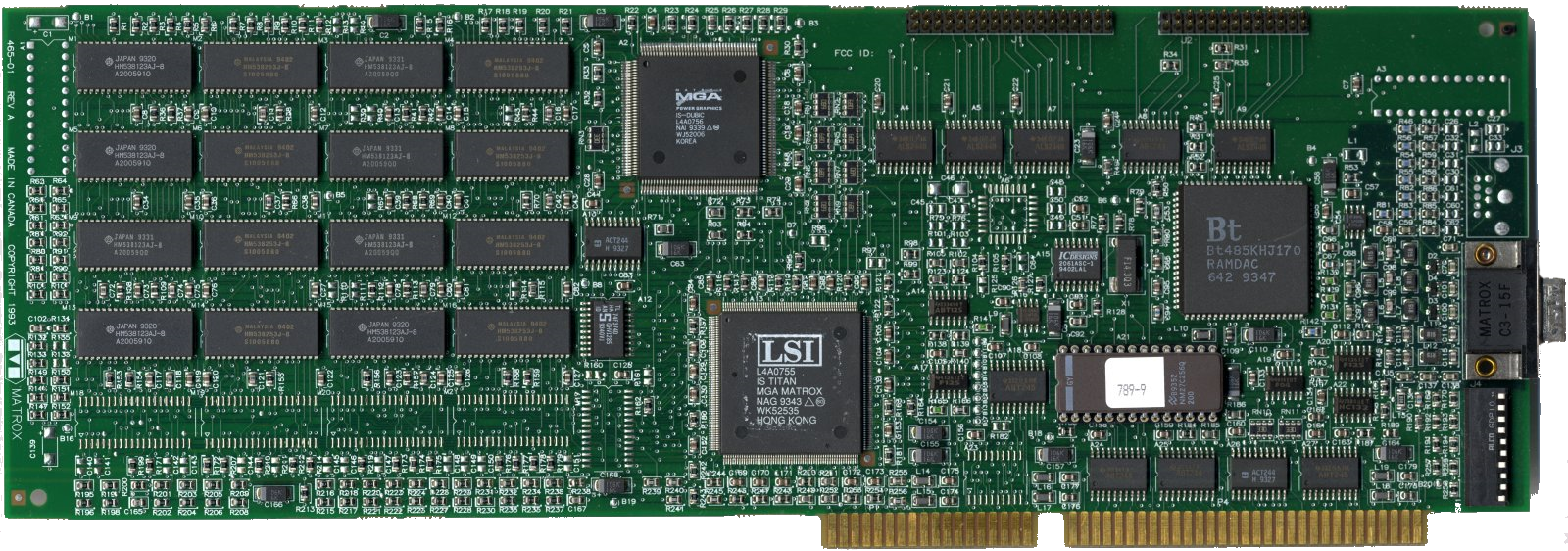
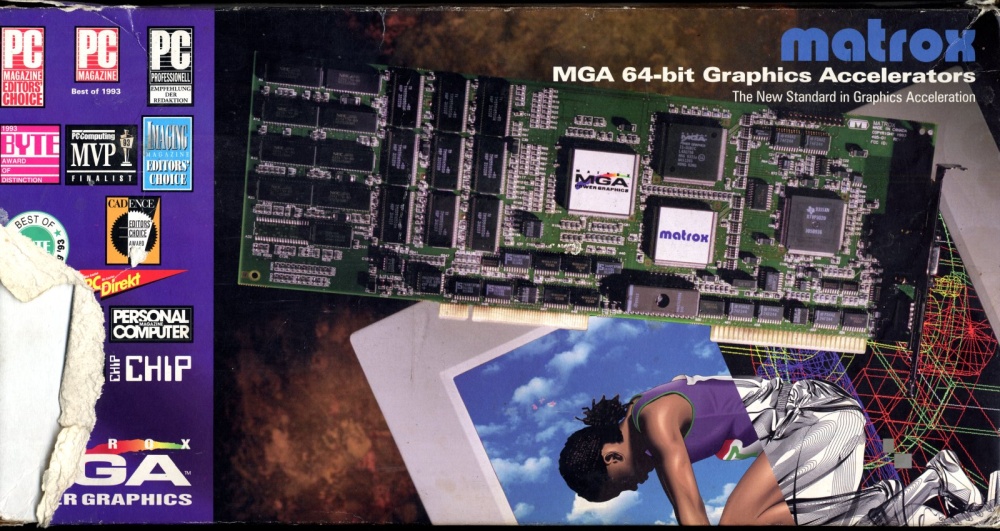

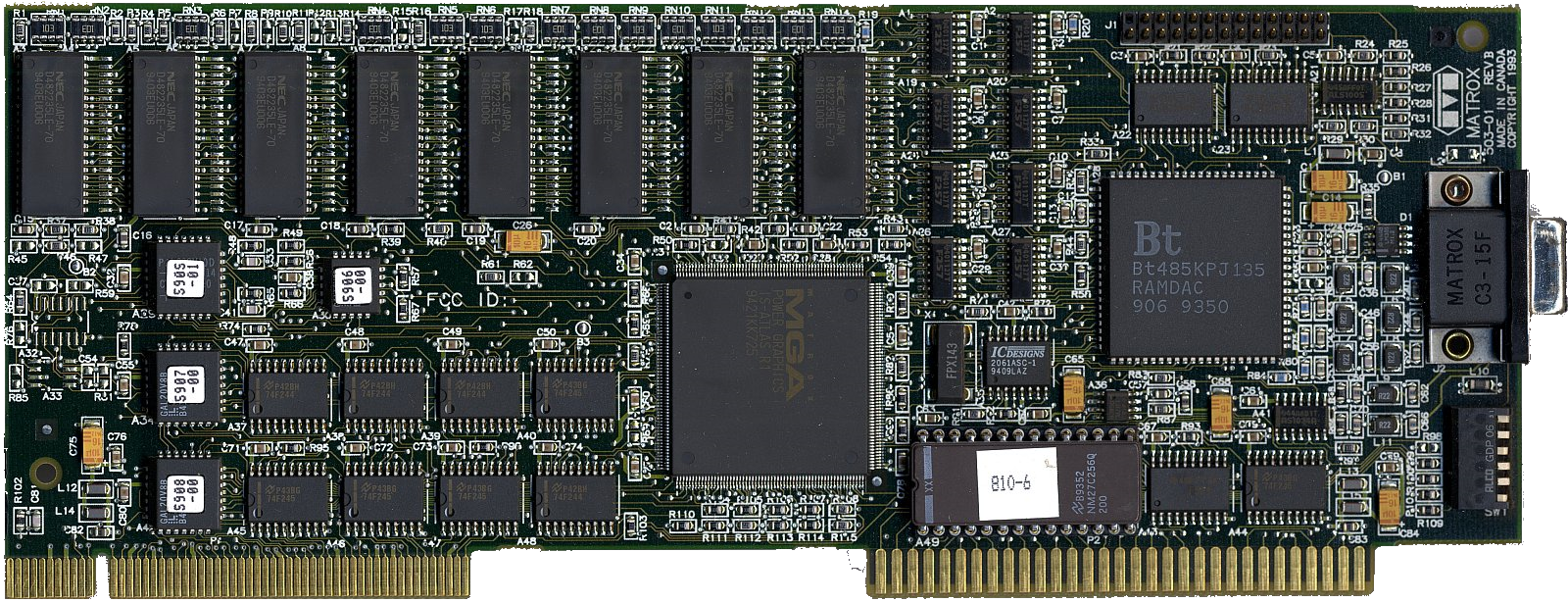

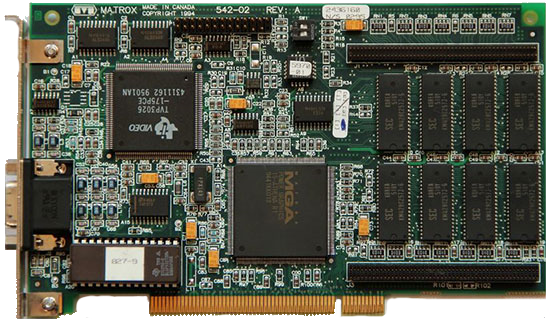
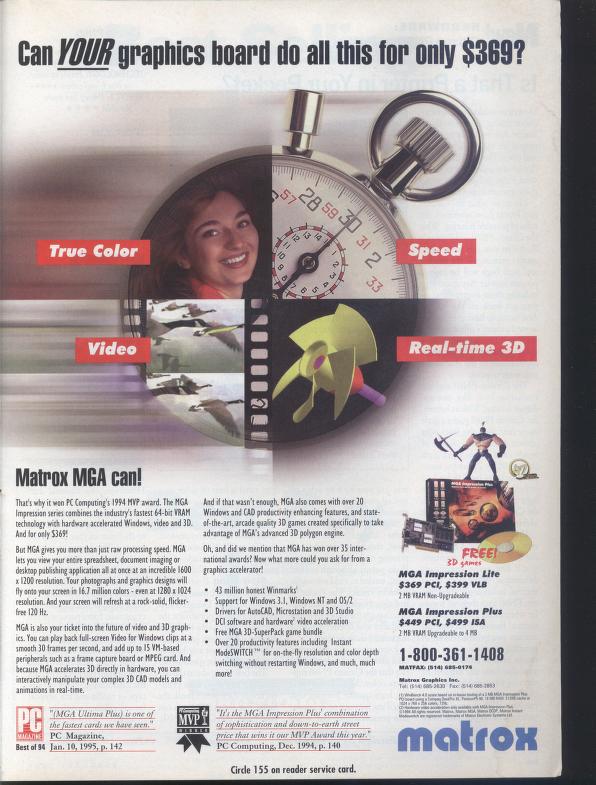
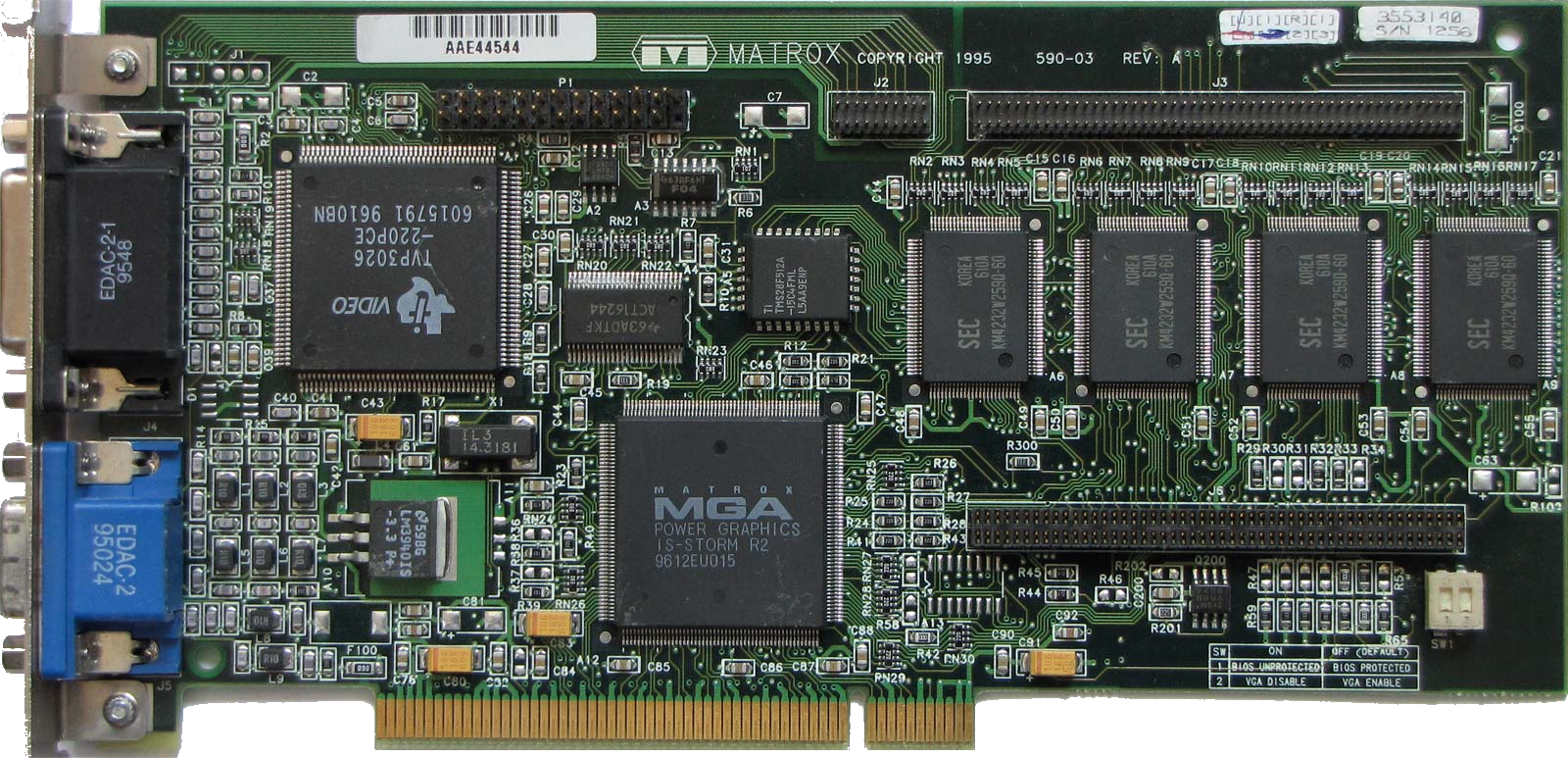
 The card had quite a price premium compared to its direct competitors at the time. Matrox integrated their 3D engine from the earlier (and market failure)
The card had quite a price premium compared to its direct competitors at the time. Matrox integrated their 3D engine from the earlier (and market failure) 